AN OVERVIEW OF ISO AND RESNA STANDARDS FOR WHEELCHAIR SEATING



“I love my Alltrack R3 Hybrid Wheel Drive! Its outdoor performance allows me to get were I want to go. The suspension gives me stability and comfort regardless of the terrain. When I’m indoors, it maneuvers like a dream!” says Benjamin Leclair
Highlights:


• Turning radius as low as 21.75”
• Patented Dual Action Suspension: Fully independent 6-wheel interactive suspension with vertical shock absorption

• Complete line of R-net expandable and non-expandable electronics




• Available with Power Center Mount Elevating & Articulating Foot Platform
• Multiple frame, drive wheel, and caster options

THE OFFICIAL PUBLICATION OF The National Registry of Rehabilitation Technology Suppliers
VOLUME 2021.5 | $5.00 USD
The opinions expressed in DIRECTIONS are those of the individual author and do not necessarily represent the opinion of the National Registry of Rehabilitation Technology Suppliers, its staff, board members or officers. For editorial opportunities, contact Amy Odom.

DIRECTIONS reserves the right to limit advertising to the space available. DIRECTIONS accepts only advertising that furthers and fosters the mission of NRRTS.
NRRTS OFFICE
5815 82nd Street, Suite 145, Box 317, Lubbock, TX 79424 P 800.976.7787 | www.nrrts.org
For all advertising inquiries, contact Bill Noelting at bnoelting@nrrts.org
EDITOR-IN-CHIEF
Amy Odom, BS
CLINICAL EDITOR
Michelle Lange, OTR, ABDA, ATP/SMS
EDITORIAL ADVISORY BOARD
Andrea Madsen, ATP, CRTS®
Annette Hodges, MA, BS
Katie Roberts, MS, ATP, CRTS®
Michelle Lange, OTR, ABDA, ATP/SMS
Weesie Walker, ATP/SMS
DESIGN
Amanda Sneed - Hartsfield Design
Reace Killebrew - Hartsfield Design
COVER CONCEPT, DESIGN
Weesie Walker, ATP/SMS








As indicated in my last President’s Message, NRRTS is approaching its 30th anniversary. My messages going forward will include complete articles from past NRRTS publications. Before there was “DIRECTIONS,” there was NRRTS News.
We look back this time to NRRTS News, Volume 4, Fall 2003. The 10th Anniversary of NRRTS. A very interesting issue. I think you will see more reprints from this publication. It’s really fascinating to look back on so many levels. Some things never change; some things completely changed. Friends who remain in our lives, and friends we have lost.
(REPRINTED FROM NRRTS NEWS, VOLUME 4, FALL 2003)
Dan Lipka, President, assumed leadership of the National Registry of Rehabilitation Technology Suppliers during the Leadership Professionalism Competence Conference in St. Louis, Missouri, August 1 & 2, 2003.

Employed by Miller’s Sales, Rental and Service in Akron, Ohio, Mr. Lipka, M.Ed., OTR/L, CRTS®, and a NRRTS Registrant since 1993 has served as vice-president in charge of membership and president-elect. Lipka, who believes strongly in the value of the ATP/ATS (CRTS®) credential, served on the RESNA board between his time as NRRTS Vice President and becoming president-elect.
Lipka stated, “Although NRRTS has grown dramatically in terms of registration, recognition and leadership, I believe there is work to do. We need to have a greater influence on policy, at both national and state levels. We need to become more visible to case management groups and demonstrate our value and cost-
Operation Wheeler Dealer, A-C-E L-P-C in St. Louis, Medtrade 2003, and companies that no longer exist as they once were. Things that you may have forgotten. Things that are fun to remember.
Since we just had NRRTS Board of Director elections, this issue of NRRTS News had the election results from 2003 and an interesting ad from our friends at Altimate Medical that I thought you might enjoy. The 2003 board also had some very interesting and very familiar comments worth reading.
As always, I hope you and those close to you remain safe and healthy.
effectiveness. We also need to do more to reduce the few “fly by night” businesses that operate fraudulently and make it difficult for legitimate RTSs to provide the highest level of services.”
Thirty percent (30%) of NRRTS Registrants returned fax-back ballots. Officers elected to join Dan Lipka and Jim Glaes, treasurer, were Anne Kieschnik, ATP, CRTS®, vice president in charge of membership, and Jerry B. Stevens, ATP, CRTS®, secretary.
Kieschnik, owner of Seating Profiles in Houston, Texas, has served on the NRRTS Board continuously since 1993 as Director and Secretary and stated, “In Texas it has been a

tumultuous year facing a state budget deficit, the fallacies surrounding our profits, the lack of knowledge
understanding of what rehab is and the coding of pediatric equipment. It is more important than ever NRRTS is active in these issues both for us as individual professionals and as a resource for states and funding sources looking for credentialed, qualified providers.”
Stevens, CRTS® and president of Advacare Medical Corporation in Olathe, Kan, is new to the board, but became a NRRTS Registrant in 1997. He said, “I believe it is time for me to move from just paying dues to investing my time and energies to benefit our profession, e.g. ‘professional rent.’”

Both ‘Weesie’ Griffin Walker, ATP, CRTS®, National Seating & Mobility, Inc., Atlanta, Georgia, and Erik Strader, P.E., ATP, CRTS®, Integrated Rehabilitation Systems, Inc., Irving, Texas, were re-elected for second two-year terms.
Walker said, “NRRTS is faced with complex issues. I believe I can be more effective in a second term with the experience I have gained.”
Strader stated, “I have made it a goal to have a career my peers can honestly judge as one who represents what is best in this industry.” Walker and Strader join Michele Gunn, ATP, CRTS®, Browning’s Pharmacy & Health Care, Orlando, Florida, and Syd Gubin, ATP, CRTS®, Home Health Supply, Inc., Palm Springs, California, as directors.
Review Chairs are vital to NRRTS, because they personally review each original application and annual renewal of 830 members.
Bills are spreading at the state level that would allow anyone to repair medical equipment. Say NO!
It is essential that authorized technicians perform all equipment repairs—properly. If you see this bill, ask your elected officials to remove CRT language.
David T. Murray, ATP, CRTS®, Dave’s Wheelchair, Inc., Hyde Park, New York, and Leslie Rigg, ATP, CRTS®, ATS Wheelchair & Medical, Boise, Idaho, were re-elected and continue to serve with Kathleen R. Riley, CRTS®, National Seating & Mobility, Inc., Mooresville, North Carolina, and Christopher Savoie, ATP, CRTS®, University of Michigan Wheelchair Seating Services, Ann Arbor, Michigan, as review chairs. David Kruse, West Linn, Oregon, is past president.
Gerry may be reached at GDCRTS@GMAIL.COM
Gerry Dickerson, ATP, CRTS®, is a 40-plus year veteran of the Durable Medical Equipment and Complex Rehab Technology industries. Dickerson, president of NRRTS, works for National Seating & Mobility in Plainview, New York. Dickerson is the recipient of the NRRTS Simon Margolis Fellow Award and is also a RESNA fellow. He has presented nationally at the RESNA conference, ISS and the National CRT conference and is a past board member of NCART.
“IT’S REALLY FASCINATING TO LOOK BACK ON SO MANY LEVELS. SOME THINGS NEVER CHANGE, SOME THINGS COMPLETELY CHANGED. FRIENDS WHO REMAIN IN OUR LIVES, AND FRIENDS WE HAVE LOST.”
Eleven-year-old Brooke Ellison was walking home from the first day of school September 4, 1990, when she was struck by a car. The accident left the young girl, who dreamed of being a dancer, paralyzed from her neck down. From that time forward, Ellison has lived her life in a wheelchair, dependent on a ventilator. However, hers is not a story of vulnerability and weakness. Ellison is an empowered, thriving woman who embraces hope and resilience as the guideposts of her life. She is dedicated to increasing the understanding of those who live with disabilities and their capacity to serve as leaders.

Ellison graduated magna cum laude with an undergraduate degree in cognitive neuroscience from Harvard University in 2000 and received her master’s degree in public policy from Harvard Kennedy School two years later. Ellison completed her Ph.D. in sociology from Stony Brook University in 2012 and is now an associate professor at the university. "Stony Brook also has the largest trauma center on Long Island," Ellison said. "That is the hospital where I was taken at the time of my accident over 30 years ago. That is the hospital that saved my life." Ellison teaches medical ethics to undergraduates who are either going into medicine or allied health professions.
"I have lived in very difficult and dark times and still have found ways to make my life rich and purposeful and create an action-oriented future," Ellison said. "Having a disability is not an impairment within one's self but is a function of many social factors. Hope and resilience are available to everyone." Ellison eagerly responds to any opportunity to share what she has learned through her life experiences. "I recently established a consulting company that will be a path to allow me to address a larger audience about inclusion and leadership opportunities for people with disabilities," She said. "I hope to reach people who may be facing times of trauma with the message of hope and resilience. I will also be working with businesses that are seeking to be more diversified and with health care workers to renew their empathy for their patients."
An effective communicator, Ellison doesn't shy away from complex issues that instill a deeper dive into understanding one's life experiences. "Understanding the

distinction between what it means to have a disability and being disabled is not simple," she said. "You can become disabled in a split second, but it is important to understand what it means to be disabled. That identity, with all of the vulnerabilities and sources of strength, takes time and work. Yes, I became paralyzed on September 4, 1990, at 1:30 in the afternoon. However, it wasn't until years later that I truly, deeply understood what that experience truly meant. It took time and maturity to understand that the life I live with a disability doesn't make me weaker or less of a person than anyone else. I can actually say 'I am a disabled woman' and feel proud of it. The word 'disabled' isn't some kind of qualifier that diminishes my identity, but instead, it actually makes, and describes, a better person. My disability encompasses a great deal of lived experience and forced innovation. Applying that qualifier to my life, in truth, indicates a sense of creativity, drive and knowledge. This realization has come to mean to me that I am not 'less than,' but rather a maximization of the human potential because I, as well as every person with a disability, have to do things so differently."
Ellison’s story was told in an autobiography published in her mid-20s and covered extensively in the national print media. She has had many interviews on network television. In 2004, her life was portrayed in an A&E television movie, "The Brooke Ellison Story," directed by Christopher Reeve, also a quadriplegic. Lacey Chabert, the popular Hallmark Movie Chanel star, played the part of a teenage Ellison in the production.
Recently, Ellison felt compelled to write a second book titled "Look Both Ways." "My first book was more reflection-driven. I'm a different person at this stage of
my life and have a different understanding of who I am," she said. "This book is deeply personal but supported by a sociological framework. I got my Ph.D. in sociology, so it is hard to separate the two. The impetus behind "Look Both Ways" was the precipitous decline in my health during the past five years. Some of the prototypical vulnerabilities that people with spinal cord injuries face were hitting me in rapid succession. I had thought I would be spared those, but that didn't turn out to be the case. My health, and indeed my life, was in jeopardy."
Beginning soon after Ellison’s 40th birthday in October 2018, she spent the next several months battling a severe pressure ulcer. "When I finished the spring academic semester the following year, I squirreled myself away in my bedroom with the lights off, curtains drawn, and began to think about what is important for others to understand about my life whenever it might come to a conclusion, hopefully later rather than sooner. That is what I wanted to write about. This book did not come easily. It is the product of years of tears and months of hard introspection."
Ellison’s writing is bold and authentic, sometimes addressing subjects that might be uncomfortable, such as how her life's circumstances impacted her family. "At the time of my accident, I made assumptions about what members of my family should accept and sacrifices they should make. I had the wrong attitude that I was the only one who had been severely, negatively impacted, and everyone
should conform to that," Ellison said. "These were things I hadn't wanted to think about earlier because it would force me to examine uncomfortable situations. But I knew I needed to consider my position in my family all of these years and its effect on them. That was a challenging chapter to write because I had to prod on some weak points in my heart. Yet, I hoped my story would touch other families who have someone recently paralyzed or diagnosed and benefit them.
As an activist, Ellison strongly emphasizes the need for change in "the messages we are giving and receiving that create an interpretation of disability that I believe is completely off base." She further explained this messaging often generally portrays people with disabilities as unwell or embittered. "Much negative messaging comes through popular culture and the media who do not accurately depict the lives of people with disabilities and creates an unfortunate image. This feeds into the way these individuals are often seen as irrelevant, invisible, or infantilized altogether. If that public perception has changed during the past decades, it has been minimally so."

"There have been many, many activists who have gone before me and paved the way. These individuals have been the driving force behind tremendous civil rights legislation in the form of the ADA (Americans with Disabilities Act) or the Rehab Act of 1973," Ellison said. "They have done enormous work just to get the basics. Now we need to go beyond basic accessibility and adaptation and access to work.

CONTINUED ON PAGE 10
"The effects of the pandemic are demoralizing, difficult, and destabilizing. I believe a message of unity and resilience can be borne from it, if we choose to allow it to happen."
"In life, we are taught to look both ways, as if there were only two."
"We tend to view our challenges as being bigger than we have the capacity to manage them, and I think that might not be fair."
"We are instinctively more vulnerable and yet stronger than we expect ourselves to be."
MORE INSIGHT FROM DR. ELLISON WORTH NOTING AND REMEMBERING: Brooke Ellison with her family at the premiere of the movie, “The Brooke Ellison Story.”We must actively deconstruct and reconstruct how disability is understood." Ellison also stresses the need for people with disabilities to be more visible in their communities in any way possible. "They should be serving in every role that others serve in whether it is on the boards of organizations, as CEOs, or as elected officials, she said. "We must reverse the idea that people with disabilities are incapable and present them as capable. Disability is so often omitted from diversity, equity and inclusion (DEI) conversations and action. I serve on several DEI-related committees and boards. Unfortunately, disabilities are often overlooked in these initiatives until I force the issue. Equity and inclusion relating to people with disabilities are the final frontiers of the DEI initiative, and we need so much more.”
In a blog, Ellison states, "… I am a fighter. My life has been shaped by adversity of all different kinds, but it has not been characterized by them. For every obstacle I have sought opportunity. In each instance of sorrow I
have sought strength. When there has been challenge and adversity I have looked for resilience and hope. That is what I want people to know about me, as that is how I see myself. That is also what I want people to know about themselves, as that is how I view the world."
"We tend to miss the positivity in our lives and focus on the negative parts," Ellison said. "To understand anyone's life you have to view it from all directions with all of its less desirable parts along with the more desirable parts. That's what makes us who we are."
In all circumstances, Ellison is dedicated to a message of leadership, resilience and inclusion. "If I can persuade people to view disabilities in ways they haven't before, that's a worthy endeavor," Ellison said. "If that is what I ride off into the distance having done, then I'll feel satisfied."



Brooke may be reached at BROOKEMELLISON@GMAIL.COM
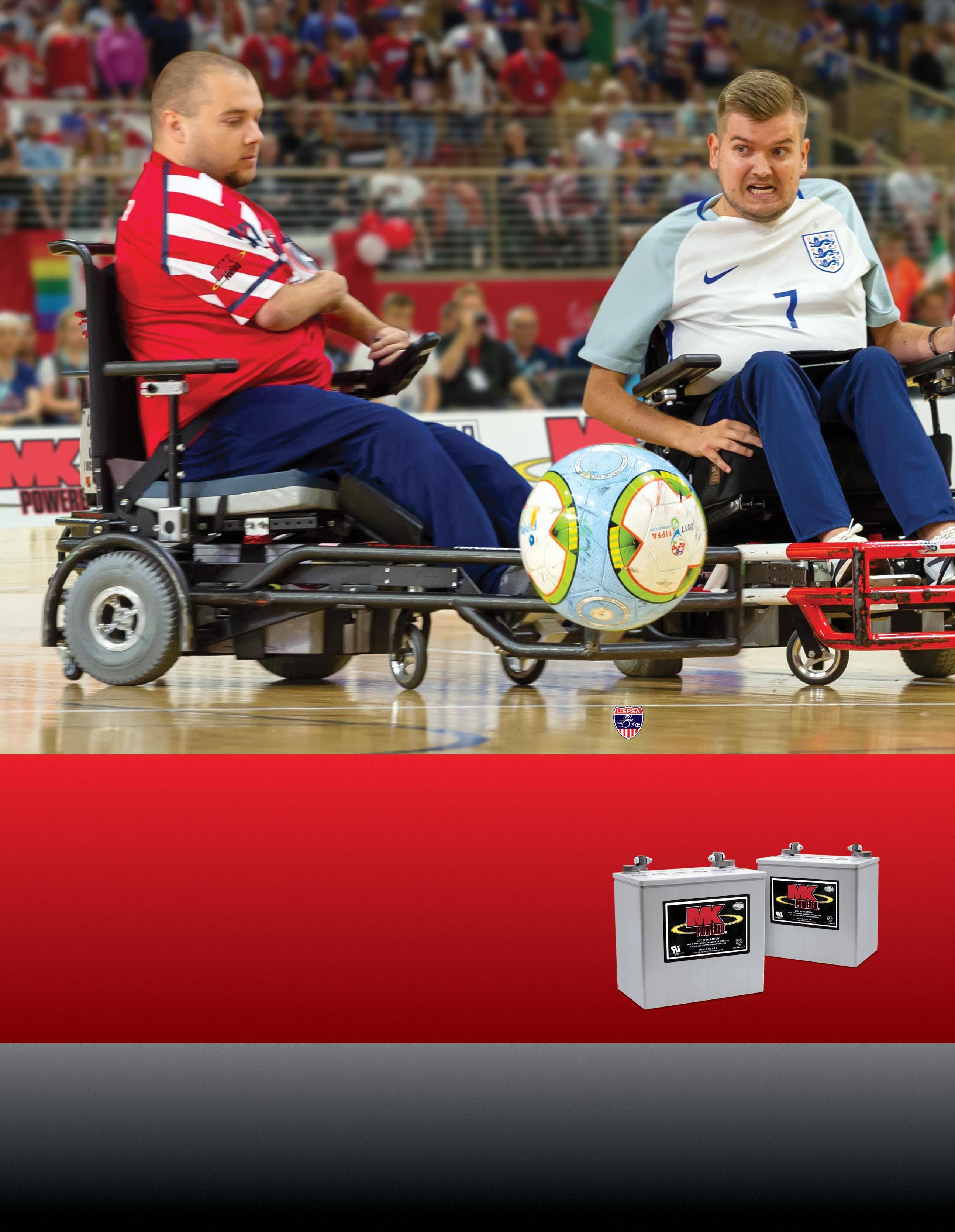
The acute focus of Jeff Bour, ATP, CRTS®, on the needs of his clients both energizes him and keeps him engaged in his work. A rehab sales representative in our industry for almost 40 years, Bour was initially drawn to rehab because of the opportunity to help others. “Trying to help clients live a better life after an injury or specific diagnosis was intriguing to me,” he said. “I’m a Christian man and love to help people, and this career provides me that opportunity day in and day out.”
Bour began as a part-time employee for White & White, a local home medical equipment supplier in Grand Rapids, in the mid-1980s while attending photography school. “I was a punk kid when I started and was sort of thrust into this work, but I went willingly knowing it would mesh well with my desire to help others,” he said. “White & White was bidding on a contract with a big rehab hospital, they needed someone to work with the therapists. That’s how I began working full time in rehab. It was a hands-on learning experience coupled with many seminars, seating symposiums and manufacturers’ in-service.”
Bour was fortunate to work alongside John Batten at White & White.
“John wanted me to work with him. He saw I had a heart for this work and I was good with my hands. He recognized we shared a compassion for helping others.
John and I meshed together and basically started rehab in West Michigan.” Bour considers Batten one of the most important mentors in his career.

“He was in a wheelchair and knew firsthand what our clients were experiencing,” Bour said.
“He had true empathy for his
clients. I learned from his example even though I couldn’t offer the same kind of connection because I didn’t have that personal experience. John would sell chairs, I would put them together, and we would make them work for our clients. We got a contract in 1986 for inpatient services at Mary Free Bed Rehabilitation Hospital and started getting really big into anything rehab – manual chairs, power chairs, pediatric products, specialty beds, standers, etc. Back then most of the chairs were steel frames, aluminum hadn’t hit the industry yet. There wasn’t much to choose from as far as seats and backs, so we would make our own, and I went to the University of Tennessee to learn more about seating.”
Bour would continue working for White & White for 16 years before he moved in 2000 to another local provider, Carelinc Medical, as the only person handling rehab sales at the time. “Our department grew steadily as we educated the environment about the rehab services we offered. Now we have a large rehab department and a great service department to support our clients.”

“I ENJOY WORKING FOR A FAMILY-OWNED BUSINESS THAT SINCERELY CARES ABOUT THE END USER. THIS CONTINUITY OF CARE FOR OUR CLIENTS IS VERY IMPORTANT TO US. WE CAN ASSURE THOSE WE SERVE THAT WE’LL PROVIDE THE SERVICE THEY NEED, WHEN THEY NEED IT. WE ARE FAMILY-OWNED AND WE TREAT CLIENTS AS THOUGH THEY ARE PART OF OUR FAMILY.”
The environment at Carelinc, a family-owned business, is ideal for Bour and his colleagues to provide high-level service their clients. “I enjoy working for a family-owned business that sincerely cares about the end user. We have our own sales and service departments, so whatever we sell, we can certainly service. This continuity of care for our clients is very important to us,” Bour said. “We can assure those we serve that we’ll provide the service they need, when they need it. We are family-owned, and we treat clients as though they are part of our family.” Carelinc has grown during the past few years expanding into Ohio and South Carolina. “We now have almost 600 employees, but our focus on providing personal service to our clients remains a priority. Mike Damstra started Carelinc in 1997 and is still president of the company. He provides a work atmosphere and support that affords me, and all of our employees, the opportunity to continue to treat our clients well.”

A graduate of Spring Arbor University with a business degree, Bour became an ATP in 2007 and has been a CRTS® since 2010. “I depend on NRRTS for my CEUs (continuing education) and the organization provides a great forum to exchange ideas,” he said. “NRRTS makes it easier and more efficient to learn about industry changes and concerns. This is very important because now the industry is full of options and changing rapidly. Thirty years ago we had to fit the client to the wheelchair. Now we fit the chair to the client. Our work is much more rewarding. If you can think it, most likely you can make it happen!”




An avid cyclist, Bour shares a love of the sport with many of his Carelinc colleagues. “Michigan State University sponsors the Gran Fondo each year and several of our employees participate,” Jeff said. “That event promotes skin cancer awareness. We also have a team participating in the PALS Ride (Peddlers for ALS) sponsored by the ALS Foundation. Our company is involved with many other events – rides, runs, races, walks – because, although we enjoy the activity, we primarily want to support the causes.”
Bour and his wife, Marcia, have two daughters, both attending Calvin University in Grand Rapids. “The oldest, Aubrey, is a junior and is studying to be an elementary school teacher,” Bour said. “Sarah just started her first semester at Calvin. She is studying to be a social worker or psychologist.” Marcia is a speech therapist in the Grand Rapids school system. “We support each other in our work. She understands some of the issues I face, and I understand part of her work. We share both the rewards and challenges.”
CONTINUED ON PAGE 14


(CONTINUED FROM PAGE 13)
Now that the Bours are officially “empty nesters,” they are considering retirement in the not too distant future. “We enjoy camping and hope to do more of that,” he said. “Once we do retire, we want to travel — with Hawaii, the Holy Land, and France high on our list.” In addition to cycling, Bour enjoys photography and working on his 1998 Jeep Cherokee that he bought new 23 years ago.
There is no doubt Bour made the right decision when he began serving rehab clients many years ago. “This is a great industry. We always have our challenges with reimbursement and other things, but I love the work and those I work with – the clients and the therapists. I have many clients who are coming to me for their fifth or sixth power chair. We have a long-standing relationship and they trust me to continue to help them. Most of those relationships are very personal. I can sense with a patient how close I can get with them, how comfortable they are with my knowing more about them. It is important to meet the client where they are. I try to always remember the saying that ‘no one cares what you know until they know that you care.’”
Jeff may be reached at JBOUR@CARELINCMED.COM.

“THIS IS A GREAT INDUSTRY. WE ALWAYS HAVE OUR CHALLENGES WITH REIMBURSEMENT AND OTHER THINGS, BUT I LOVE THE WORK.”




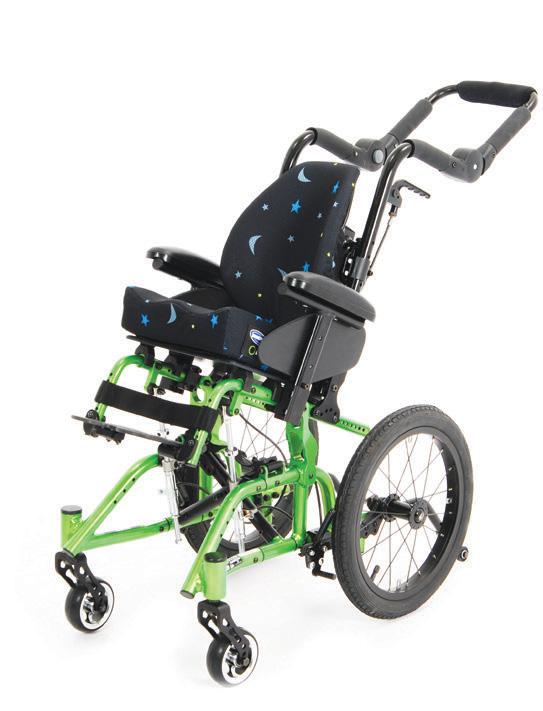


Over the past 20 months Complex Rehab Technology (CRT) providers and manufacturers have incurred significant operating challenges and increased expenses from the COVID-19 pandemic. It’s been a tough time.
Unfortunately, CRT suppliers do not have the ability to raise prices to cover the increased costs as they are subject to Medicare, Medicaid, and other third-party payer fee schedules, which frequently index off of Medicare rates. These challenges and increases are significant and federal relief must be provided.
CRT suppliers and manufacturers work hard to ensure that people with disabilities have continued access to the important CRT products and supporting services they need to maintain their independence and health. However, unlike other sectors, CRT suppliers are constrained by pre-determined pricing structures that fail to factor in the new operating and cost realities of providing CRT and supplies. The challenges and increased costs include the following:
• Increased expenses related to the provision of personal protective equipment (PPE) for both their employees and customers.
• Increased payroll expenses due to the COVID-19 environment and the need to retain qualified staff in a time of national workforce shortages.
• Increased freight charges.
• Difficulties in obtaining products and supplies in a timely manner due to supply chain challenges.
• Increased raw material costs, product costs, and related surcharges.
• Increased distribution expenses related to higher gas prices.
There are also major concerns about the high demand across a number of industries for microchips, the ability for the relatively small CRT industry to procure microchips in the face of shortages, and the impact that limited supply will have on the users of CRT power wheelchairs. Without microchips, power wheelchairs cannot be built, completed and shipped to users who rely upon these chairs for their mobility and independence.
Adequate access to CRT products and supporting services is critical to minimizing health care costs from medical complications and interventions. It is also needed to allow people with disabilities to maximize their independence. These challenges and costs are not temporary and will continue into the future.
We are working to convey to Congress that without additional financial support it may become costprohibitive for providers to continue providing CRT products and supporting services to people with disabilities who depend on them to maintain their independence and to reduce medical interventions and expenses. A disruption in access will lead to adverse health outcomes and increased overall costs of care.
We urge Congress to provide the needed federal financial assistance to address these important access issues.
The First-Ever NCART/NRRTS CRT Virtual Congressional Fly-In was held on Tuesday, September 21. We will be sharing more details in the coming weeks. This remote opportunity offered stakeholders the ability to communicate CRT messages to their members of Congress. There were three “Congressional Asks” that attendees focused on:
ASK 1: Sign on to the bipartisan Congressional letter to Centers for Medicare and Medicaid Services (CMS) Administrator Chiquita Brooks-LaSure asking CMS to move forward with the pending coverage request for power seat elevation and standing systems on CRT power wheelchairs. Medicare currently DOES NOT cover funding of power seat elevation and power standing systems used with CRT power wheelchairs. Evidence shows these CRT systems provide significant medical benefits and enable people with disabilities to be much more independent in their home and community settings. Unfortunately, CMS’ review of the coverage request has not formally progressed, and it needs to move forward.
ASK 2: Federal financial assistance is needed so it does not become cost prohibitive for CRT companies to continue to provide the equipment and services needed by people with disabilities. As described in the narrative above, CRT suppliers and manufacturers have incurred significant operating challenges and increased expenses from the COVID-19 pandemic that must be addressed.
ASK 3: Recognize the benefits of unique CRT telehealth flexibilities put in place during the public health emergency and ensure they continue beyond the pandemic to protect patient access. The ability for occupational and physical therapists (OTs and PTs) to provide CRT related telehealth services has been extremely beneficial for people with disabilities, but will end when the COVID-19 public health emergency expires. This telehealth option must be made permanent so OTs and PTs can, when the situation requires, participate remotely for CRT evaluations, fittings and training when an in-person visit is not possible due to medical risks, transportation barriers, lack of experienced clinicians in the community and other factors. Rather than allowing these proven flexibilities to expire, Congress and CMS should make these CRT telehealth policies permanent.
Standing devices have a long history of prescription and use to provide important medical benefits and other positive outcomes for children and adults with disabilities. This specialized equipment plays an important role in reducing medical complications, clinical interventions and hospitalizations.
Unfortunately, suppliers and clinicians see frequent inappropriate denials from third-party funding sources. These denials often stem from a lack of awareness of the evidence of medical benefits and of reduced interventions that come from proper prescription and utilization.
To help address this access issue, NCART and the Clinician Task Force have published “Evidence-Based Response to Insurance Denials of Standing Devices”. The guide is designed to provide helpful information to policymakers and health insurance plans regarding the proper coverage and funding of standing devices for children and adults with disabilities. It includes evidence related to the benefits and positive outcomes that result from appropriate use.

The publication can be downloaded at www.ncart.us or www.clinciantaskforce.us
California Gov. Gavin Newsom has signed Assembly Bill 133 (AB-133) into law, which brings major enhancements to the Medi-Cal program and includes language to improve and protect access to CRT for Californians with disabilities.
The CRT provision has two components: (a) it permanently exempts CRT from a long-standing Medi-Cal provider cut of 10% and (b) it strengthens policies regarding the evaluation and delivery of CRT. These are big wins for CRT access in California. This is also the eighth state to pass CRT-focused legislation, joining the states of Colorado, Connecticut, Illinois, Oklahoma, Tennessee, Washington and Wisconsin.
Legislative champion Sen. Bill Dodd said, “We must do all we can to ensure people with disabilities get the specialized equipment they need that allows them to live their lives to the fullest.” He continued, “Also, we must ensure this vulnerable population has access to a
CONTINUED ON PAGE 18

For 20 years, PRM continues to be on the leading edge of custom rehab seating design and innovation. As we look back on the past two decades, we couldn’t be more proud of what we’ve accomplished along the way. A heartfelt thank you goes out to our valued customers and dedicated associates who’ve taken this journey with us. You’re the reason we’re twenty years in—and still going strong. As we move forward, the global pandemic has forced us all to adapt. While many have struggled, we’ve continued to focus on our customers. Our lead times remain unmatched at less than two weeks—and we’ve upgraded internally with new milling equipment and editing software to streamline workflow with external digitizing systems. This represents increased value and quality to our customers. That’s the PRM way. Thank you again for helping us get here, we’re looking forward to the next 20 years and beyond.




EARLY
FALL CRT UPDATE (CONTINUED FROM PAGE 17)
network of qualified suppliers. With passage of the health trailer bill, we are doing that, achieving a level of dignity people deserve. I thank my colleagues for seeing the value in the proposal.”
NCART and its members worked closely with Dodd and his staff to educate California legislators and policymakers on the need for these improvements. Other supporters included the California Association of Medical Product Suppliers (CAMPS), California Children’s Hospital Association, Children’s Specialty Care Coalition, Disability Rights California, Advanced Medical Technology Association, Spinal Care Network, National Multiple Sclerosis Society, Care to You Health and AdvaMed.

NCART is your national advocacy association dedicated to protecting CRT access. To continue our work, we depend on membership support to take on important federal and state activities. If you are a CRT provider or manufacturer and are not yet an NCART member, please consider joining. For information visit the membership area at www.ncart.us
Don may be reached at DCLAYBACK@NCART.US

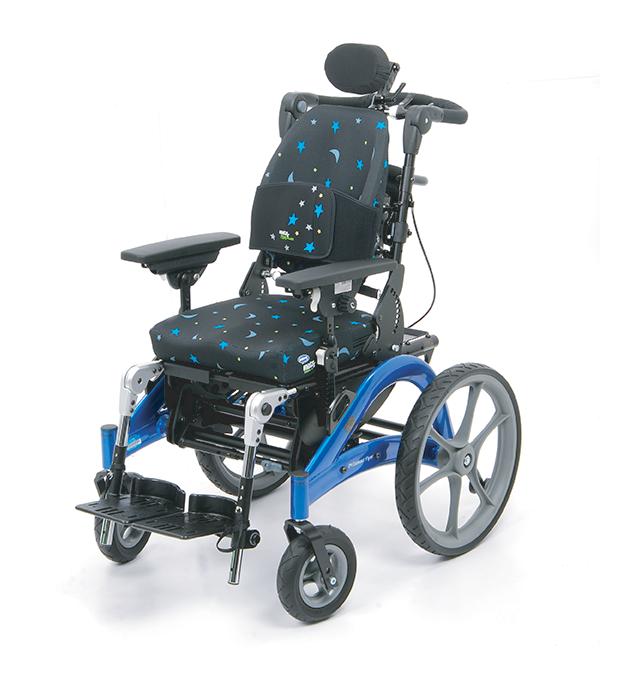


Little ones just want to move! There is something universal about a child’s desire to move and play that transcends disability and country. In 2018, I had the privilege of traveling to Lima, Peru, with Eleanore’s Project to serve a wheelchair clinic at Yancana Huasy, a specialized school and community center. I thought I was prepared to deal with some challenging situations, but I found unexpected opportunities.
Children, families and therapists at Yancana Huasy face mountains every day. The school is situated in one of the poorest neighborhoods of this large South American city, and their wheelchair clinic serves children and families up to several hours travel away by bus, taxi, motorcycle and foot. The most affordable land to live on is the steepest. It is not uncommon for a parent to carry their child up a long flight of steps carved into the hillside, lay them down at home, and come back down the stairs to carry their child’s wheelchair up next. With travel (“mobilidad”) such an obstacle, the wheelchair clinic at Yancana Huasy, in partnership with Eleanore’s Project, has adapted by combining several visits into one long day.
Eleanore’s Project is a nonprofit organization based in Missoula, Montana, led by Tamara Kittelson-Aldred, OTR/L, ATP/SMS, whose own daughter, Eleanore, was a wheelchair rider before passing away from disability related complications. Since 2007, Eleanore’s Project has partnered with Yancana Huasy to increase therapists’ capacity to evaluate and provide well-fitted wheelchairs for children in their community. The project includes training and mentor-ship for local therapists, as well as yearly visits by a team of Complex Rehab Technology (CRT) professionals and occupational therapy (OT) students from the United States to support a two-week wheelchair clinic where donated and purchased wheelchairs are fitted to their new riders. Over the course of the year, wheelchair evaluations occur at the school in preparation for the yearly clinic. Recommendations about the general size and type of wheelchair needed are shared with the volunteer Eleanore’s Project team, who procure and pack a shipping container full of wheelchair frames and accessories to match the needs identified during the child’s wheelchair evaluation.
The wheelchair service provision for Eleanore’s Project at Yancana Huasy includes a detailed and intentional process:
1. The local wheelchair evaluation indicates the needs of each child.
2. Parents participate in mandatory training through workshops about supported positioning in lying, giving children immediate access to posture care while waiting for wheelchairs.
3. Donated and purchased equipment selected for the children are packed into a shipping container and sent from the United States to Yancana Huasy.
4. Parents participate in mandatory training in wheelchair care and maintenance to support practices to keep their child’s wheelchair in good working order.
5. Occupational therapy students from St. Catherine University, who were selected to travel with the team, complete a 2-day 24-7 postural care training course in preparation to serve families in Peru.

6. In collaboration with local therapists and technicians, equipment provision occurs with custom fitting on the day of delivery. Most families spend all day at the clinic while their chairs are assembled and fitted. In the context of limited resources, therapists and techs sew, carve foam, and wield wrenches to create custom cushions, covers, laterals and more. The long day facilitates peer-to-peer support, parent-to-parent support and family training by local therapists, Eleanore’s Project therapists, Assistive Technology Professionals (ATPs) and OT students.
7. Social workers discuss needs for transition to school and assist with transportation and other needs, including the return visit to clinic.
8. Families sign a contract to agree to maintain the wheelchair as instructed, implement 24-7 posture care management, and return to clinic every six months for follow-up assessments, growth adjustments and maintenance.
When the day finally came to welcome families to the clinic and build the chairs, excitement was high! Upon arriving at the church sanctuary within the school, each family was directed to a mat table and greeted by their therapist/ATP/OT student team. The team reviews the wheelchair evaluation - now months old - including posture and mat assessment. With this information in hand, the team retrieves the earmarked wheelchair, evaluates its appropriateness, and modifies it as needed.
For the parents, it is a long day, and a hopeful one, as they get to imagine a future for their kids that includes mobility and a greater degree of independence and self-determination. The kids also gain new perspectives, including:
• I get to sit by myself for the first time - is it fun or scary?
• I get to eat/be fed with eye contact. It’s fun being face to face! I can use my hands now!
• I can gesture/ point and eye gaze to communicate and Mom and Dad can see me do it, because they are in front of me!
• I can go!
The highlight of the trip occurred during a hot, sweaty afternoon when the kids seemed to have decided that wheels are for rolling. Ariana, a 15-year-old with a mid-thoracic spinal cord injury, initiated the fun. Ari was
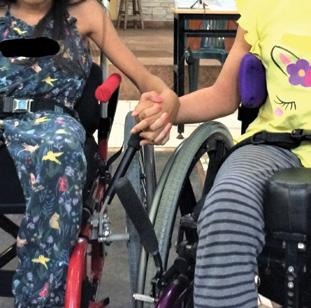
an experienced wheelchair user, but on this day, she received her first ultralight wheelchair. She was excited about the chair because it would help her travel the required distances at her new high school where she was studying pre-med. Ariana was doing doughnuts on the smooth, fast floor, and her friend, Maria, who was 12, and has cerebral palsy (CP), was watching. Before long, Maria got her hands on her wheels and rolled over to Arianna. Jesús, who was 7 and also has CP, saw what the girls were doing and surprised us all by getting his hands on the large wheels of his new tilt in space manual wheelchair - and getting it to move. Jesús had not shown much functional use of his hands previously but was now seated in a properly fitted wheelchair and discovered he could get his hands onto the wheels without losing his balance and falling forward. The parents of another small girl, about 4 years old, saw all of this and encouraged their daughter to “push, push” with her hands to get out and join the kids. Soon, even the non-mobile kids were out on the floor with help from their parents and everyone was doing doughnuts!
You could not wipe the smile off my face that afternoon - even though it was hot, and I was sweaty and dirty from working on wheelchairs all day. Limited resources meant the kids and their families had to spend the whole day waiting while their chairs were modified, and we were in a big space with no privacy. Yet it also meant that the kids and families were able to support each other, with the older kids showing the smaller kids what a difference a wheelchair can make!
Patricia may be reached at TRISHTOOLEOT@GMAIL.COM.
Patricia Toole, OTR/L, MsOT, MAT, ATP, MOM, is an occupational therapist with 23 years of lived experience in assistive technology, seating, positioning and postural care. As a mom of three active boys, including, Alex, 23, who lives with spastic quadriplegia cerebral palsy, she knows first-hand how important it is to listen well, to empower a person’s first circle of support, and to have a long-haul perspective. She has worked professionally in the areas of assistive technology, wheeled mobility and positioning for the last 15 years including 10 years leading the seating clinic at PROVAIL in Seattle, and is now owner of Clear Path Occupational Therapy, teaches continuing education courses for therapists and families, and treats with RehabWithoutWalls.

 Written by: ROSA WALSTON LATIMER
Written by: ROSA WALSTON LATIMER
In January of this year, Rick Nori took his 32 years of experience in the Complex Rehab Technology (CRT) and Home Medical Equipment industries to National Seating & Mobility Canada to guide that company’s growth as regional area director. Bill Mixon, National Seating & Mobility’s CEO, described Nori in a press release as “a well-respected industry veteran who will be a key contributor to shaping the future of our growing Canada business.”
“I met the folks from NSM a couple of years ago and realized we shared some of the same principles, so when this opportunity presented itself, it was an easy decision,” Nori said. “The opportunity to help grow NSM in Canada was attractive to me as I love building things. It is personally fulfilling to see companies grow and expand, and I am experiencing that. We just acquired 10 locations in Eastern Canada, so we now have businesses in five provinces.”
I realized if I was going to make a career change, I wanted as close to a perfect fit as possible. I saw a commitment to quality service in the leadership team and culture. This commitment aligns with how I want to spend the remainder of my career. I recognized this opportunity as a long-term landing spot for me with like-minded people. The National Seating & Mobility culture is built around “servant leadership” with the philosophy that “leader” is an action verb. We are committed to supporting our staff to be successful because, ultimately, they serve our customers. We wake up every morning, and we have choices in life that often our customers don’t have. They need their equipment, they need everything that we provide, and we are committed to serving their needs.
I also appreciate that National Seating & Mobility is a true complex rehab company. The leadership is longtime rehab folks who have a great understanding of our industry. They recognize the value in making sure ongoing education is part of our offering to our ATPs. If I can’t look after my staff and their needs, I can’t be that servant leader.
My first job was as a salesperson for a small company in Calgary, and it was there I learned about the industry. From there, I worked as a sales rep and then moved to customer service and sales management. I uprooted my family and moved from Calgary to Vancouver to become part owner in a small HME business. I worked there for a short time before Shoppers Home Healthcare acquired us. I’m an entrepreneur at heart and having a stake in the business was important to me. So, once Shoppers bought us, I looked for other opportunities and went to work at Motion Specialties. I was there nine years, and then they were acquired by a larger company as well.
In 2014 I started a distribution business that was totally different from the supplier side of our industry. I truly enjoyed this role as it gave me a chance to meet suppliers across the country. Ultimately, we were purchased in 2018 by Ki Mobility of Wisconsin, and I was with Ki Mobility for the past two years before I moved to National Seating & Mobility this year.
YOU’VE GIVEN US A CLEAR IDEA OF HOW YOU VIEW A LEADER’S ROLE. WHAT ELSE DO YOU CONSIDER NECESSARY AS YOU INTERACT WITH YOUR STAFF?
As you create a positive culture in a business and empower staff to make good decisions, I believe they will make the right decision for the client. If you set parameters based on the values of your company, the staff will follow your lead. I’m not a micromanager – that would be impossible. We grew from 160 employees to over 300 last week with the acquisition of the Canada Care Group. We have to empower our leaders to make their own decisions, sometimes on the “fly.”
It is essential to look for leaders within our company, and I try to create a career path for them. It is rewarding to see other individuals with an opportunity for a future in our industry. I look at the group I’ve grown up with throughout my career, and many are looking at retirement. The next generation to take over our work isn’t evident. I think it is up to us to identify future leaders and nurture them. Finding the right people can be difficult, but I see every challenge as an opportunity.
I believe it is a generational issue. In the past, we would stay with one job for a lengthy time. We didn’t make many changes, and sometimes we worked six to seven days a week. There has been a shift in work/ life balance, and perhaps the younger generations understand that better than we did. However, we are a 24/7 business. The needs of our customers don’t
necessarily fit in a shorter workweek. I believe we should consider the work/ life balance notion and engage with our employees to support them and offer viable solutions that still maintain our quality of service to our clients. As leaders, we also need to lead by example.
My family is very important to me. We enjoy spending time at our place on the lake and being outdoors together. I have three grown children. My son, Joel, is operations manager for Ki Mobility Canada. My oldest daughter, Danielle, is a social worker, and my youngest, Kayla, is a hotel manager. My wife, Carole Ann, is an educator for a large Canadian insurance company. And, we have a new Cockapoo puppy, Jax, who was our COVID acquisition.
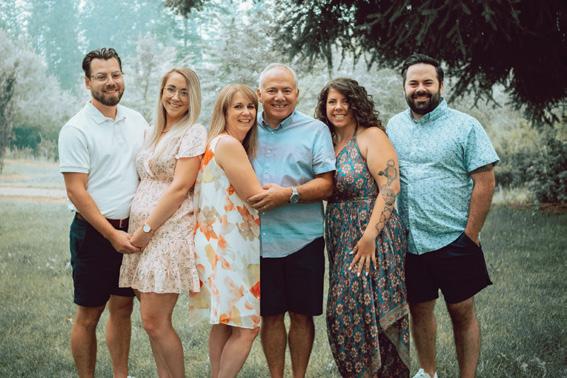
I enjoy golfing, and I belong to a curling league that competes once a week. I’m also a wine enthusiast and enjoy collecting wine. British Columbia has over 350 wineries offering some of the best wines in North America. I just fell in love with the whole area and especially enjoy meeting the small mom and pop producers.

HOW DO YOU SUPPORT THE CRT INDUSTRY IN A BROADER SENSE BEYOND YOUR RESPONSIBILITIES AT NATIONAL SEATING & MOBILITY?
I have served on the board of directors of the Ontario Home Medical Equipment Providers Association since 2018, and I am also a member of the board of directors of the Home Medical Equipment Providers
CONTINUED ON PAGE 24
“I REALIZED THAT IF I WAS GOING TO MAKE A CAREER CHANGE, I WANTED AS CLOSE TO A PERFECT FIT AS POSSIBLE.”The Nori Family: (l to r) Son-in-law, Matthew; daughter, Kayla; Carole Ann; Rick; daughter, Danielle; and son, Joel.
(CONTINUED FROM PAGE 23)
of British Columbia. These organizations are committed to making our industry more effective by supporting a high standard of care and professionalism.
As I’ve said, I’m a big proponent of education and am excited about the opportunities available through our affiliation with NRRTS. Since I began working with National Seating & Mobility, 90% of our sales team in British Columbia have earned their NRRTS certification. In the U.S., you must be an ATP to provide complex rehab equipment. We don’t have that same regulation in Canada. We are committed to educating our funders and clinicians about the value of the standardization of service these certifications provide.
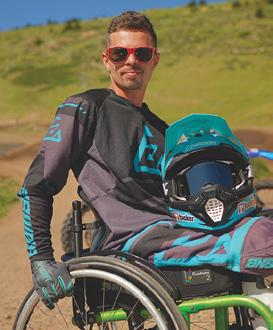

Our NRRTS affiliation is an asset. It is essential to consider the industry as a whole and help move it forward. We must roll up our sleeves, work together and make things happen!
Rick may be reached at RICK.NORI@NSM-SEATING.COM.

Rick Nori is regional area director for National Seating & Mobility Canada, leading branch operations throughout Canada. He serves on the board of directors of the Ontario Home Medical Equipment Providers Association and the Home Medical Equipment Providers of British Columbia.

WEDNESDAY, OCTOBER 20, 2021, AT 11 AM ET
Adaptive Tricycles: The Other Wheeled Mobility Device and Therapy Tool Addressing Domains of the International Classification of Function, Disability and Health (ICF)
Dan Judson, registered physical therapist, B.Sc.P.T 1988, Western University, London Ontario

Sponsored by Freedom Concepts
Seating & Positioning, Business Practice, Beginner Level
Cycling is well-established in our culture as a tool for fitness, health, recreation, transportation and achieving independence. We celebrate learning to ride a cycle as a rite of passage and then may continue to reap the benefits for decades. Individuals with physical and/or cognitive challenges that make it difficult to ride safely can benefit from cycling if they are properly positioned and supported on a well-configured cycle. The benefits of cycling can include enhancements to gross motor skills, joint range of motion, muscle strength, bone growth, cardiovascular fitness, visual/spatial orientation, and quality of life for the child and family. This course will examine the clinical benefits and research regarding adaptive tricycles through the lens of evidence-based practice and justify them as a therapy tool to address domains outlined by the ICF: body functions and structures, activity, and participation in the context of environmental and personal factors.
• The participant will be able to list at least four benefits related to the ICF afforded to children with a disability from having access to riding an adaptive tricycle.
• The participant will be able to discuss evidence-based research related to the use of adaptive tricycles, and those areas that require further investigation.
• The participant will be better able to construct a letter of justification/medical necessity to support funding requests for adaptive tricycles.
For more information, visit the website www.nrrts.org
THESE LIVE WEBINARS ARE AVAILABLE AFTER THE PRESENTATION DATE IN THE ON-DEMAND LIBRARY.
TUESDAY, NOVEMBER 9, 2021, AT 7 PM ET
Anna Sokol, RN, MN, BScN, BScKin

Sponsored by Motion Concepts
The world has recently been shaken by the COVID-19 pandemic. All industries have been affected and have had to change the way people work and provide services. This presentation will focus on the chain of infection transmission and the ways to break that chain in relation to seating and mobility.
Participants will be provided with information related to routine, contact, droplet and airborne precautions. Additional precautions required during the pandemic will be compared with routine practices during non-pandemic times. Special attention will be paid to proper hand washing techniques and methods. Examples and case studies will include components of assessment and decision making related to the use of an appropriate level of protection and personal protective equipment (PPE).. Pathogens will be classified according to the required methods of infection control. Discussion about engineering controls related to the reservoirs of infection will touch on the latest available technologies related to seating and mobility.
LEARNING OUTCOMES:
• The participant will be able to describe the six links of the chain of infection transmission and the ways to break it.
• The participant will be able to identify at least three routines and at least two additional practices recommended during the COVID-19 pandemic.
• The participant will be able to list at least three modes of transmission requiring use of the PPE and additional precautions.
WEDNESDAY, NOVEMBER 10, 2021, AT 11 AM ET
Greg Packer, MS, MBA

Sponsored by US Rehab
ATP/SMS Prep Content, Best Business Practice, Intermediate Level
This course provides current information on general outcomes through the FMA. It gives the principles and applications for utilizing the tool in the current working environment with Complex Rehab Technology users. It also will show current data and performance of how users are tracked and monitored for specific types of outcomes like wounds, falls and hospital remittance.
LEARNING OUTCOMES:
• The participant will be able to identify 10 different ways data from the FMA/Uniform Dataset (UDS) mobility registry can be utilized.
• The participant will be able to identify three iterations of the FMA/UDS tool.
• The participant will be able to describe three benefits of utilizing the registry and one discrete analysis from the data set.
For more information, visit the website www.nrrts.org
Angie Kiger, M.Ed., CTRS, ATP/SMS

Sponsored by Sunrise Medical
ATP/SMS Prep Content, Best Business Practice, Intermediate Level
Has the thought “If only they would’ve told me that, I would’ve recommended a different type of wheelchair,” ever come to your mind when you realize things aren’t going well with a client’s new piece of equipment? What about the thought “They are over the top with the demands,” when you aren’t seeing eye to eye with a caregiver about their loved one’s Complex Rehab Technology (CRT) needs? If you can relate to either of those questions, you have probably experienced other communication breakdowns when attempting to provide the most appropriate CRT for a client and/or the best overall client experience for them. Establishing a solid rapport with a client is vital to not only ensuring improved outcomes but also to your client’s overall level of satisfaction. This educational session will provide participants with strategies to building effective professional relationships with their clients for successful outcomes in the provision of CRT.
LEARNING OUTCOMES:
• The participant will be able to list and describe six key areas of communication to focus on to enhance client-centered communication skills.
• The participant will be able to identify at least three strategies to incorporate into the evaluation process to foster open communication and build rapport with clients.
• The participant will be able to describe three examples of how information gathered outside of the traditional interview method, measurements, and diagnoses can impact the selection process for the most appropriate complex rehabilitation technology for a client.
TUESDAY, DECEMBER 7, 2021, AT 7 PM ET
Theresa Marie Crytzer, PT, DPT, ATP

ATP/SMS Prep Content, Medical Terminology, Seating & Positioning, Intermediate Level
Cardiopulmonary function, particularly in people with neurological disabilities, is often compromised. The extent of compromise depends on physiological factors including neurological level and denervation of the muscles of respiration and the presence of scoliosis and kyphosis. Wheelchair positioning and mobility can impact cardiopulmonary function and chest wall expansion. Measurement of cardiopulmonary function is important to consider in therapist evaluation and to include in documentation for wheelchair seating. Adaptive exercise and daily physical activity can improve cardiopulmonary function. This course will provide a review of cardiopulmonary impairments and secondary conditions associated with neurological diagnoses, examine how outcome measures can support clinical judgment and inform letters of medical necessity, provide an overview of the impact of positioning and seating on cardiopulmonary function, and discuss options for improving cardiopulmonary fitness in wheelchair users.
LEARNING OUTCOMES:
• The participant will be able to discuss impairments associated with people with neurological conditions and secondary conditions that can impact morbidity and mortality.
• The participant will be able to review five cardiopulmonary outcome measures and ways that they can support clinical decisionmaking in wheelchair prescription.
• The participant will be able to examine the impact of wheelchair positioning and seating cardiopulmonary function.
• The participant will be able to examine the impact of physical activity on cardiopulmonary function and options for improving cardiopulmonary fitness in wheelchair users.
In a time of drastic change, it is the learners who inherit the future. We appreciate our learners’ willingness to adapt to the ever-changing sphere of Complex Rehab Technology, even before COVID hit our world.
We have over 100 on-demand webinars and CEU articles in our library that cover a variety of topics on seating and positioning, medical terminology, ethics, funding and best business practice.
The education program awarded over 1,356 CEUS from August 2019 to August 2020 — that equals 13,560 hours of education!
The numbers are proof that we are meeting one of our education objectives at NRRTS — to bring you quality education at an affordable price. Registrants receive education at no cost, as a benefit. FONS pay half-price and others only $45 per course!
We’ve made access to education affordable, and NOW, even easier for our learners!
NRRTS is accredited by the International Association for Continuing Education and Training (IACET). NRRTS complies with the ANSI/IACET Standard, which is recognized internationally as a standard of excellence in instructional practices. As a result of this accreditation, NRRTS is authorized to issue the IACET CEU.
IACET CEUs are accepted by NRRTS for the RRTS® and CRTS® credentials and by RESNA for the ATP and SMS certification renewal. The National Board for Certification in Occupational Therapy Inc. (NBCOT) accepts the IACET CEUs as PDUs for the American Occupational Therapy Association (AOTA). State occupational and physical therapy associations also accept IACET CEUs for license renewal.
For more information, visit the website www.nrrts.org


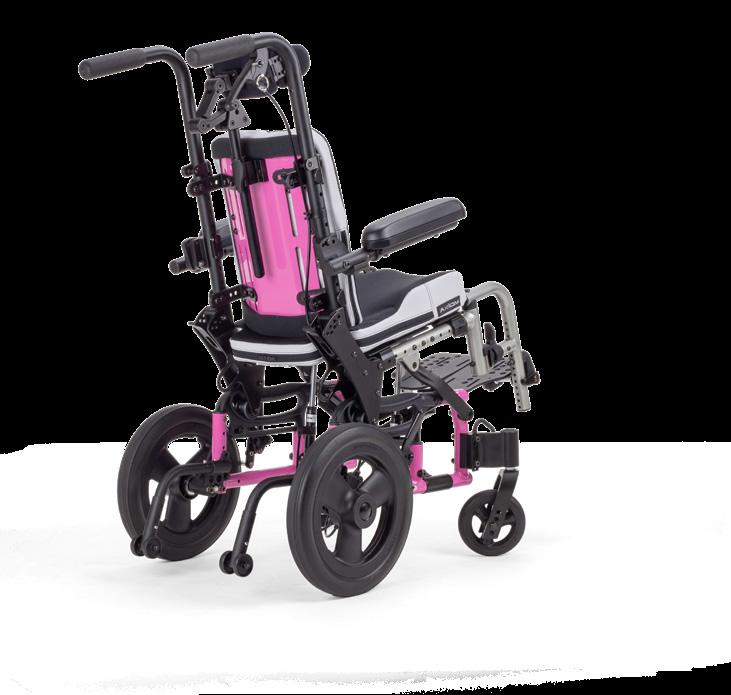


For decades, test standards have been developed to measure and characterize wheelchair seating. These tests measure critical characteristics of wheelchair cushions, revealing properties that might be suitable for meeting client’s needs for tissue protection, positioning and ADLs.
In this article, we’ll review how standards are created, look at a few specific tests and demonstrate how test data can inform the cushion selection process. Benefits and limitations of the test data will also be discussed.
CONTINUED ON PAGE 32
NRRTS is pleased to offer another CEU article. This article is approved by NRRTS, as an accredited provider, for .1 CEU. After reading the article, please visit http://bit.ly/ CEUARTICLE to order the article. Upon passing the exam, you will be sent a CEU certificate.


ISO standards are developed by global volunteers, including technical experts, clinicians, regulators and end users, through technical committees under the International Organization for Standardization (ISO). Such activities began over a hundred years ago with the essential question: What’s the best way to do something? There are currently over 20,000 published standards for products and services that affect all aspects of our lives. Over 240 committees of volunteers develop these standards with the goals of ensuring safety, quality, reliability and in the case of medical devices, clinical effectiveness. The wheelchair standards fall under the assistive product technical committee (ISO TC 173) as a specific subcommittee (SC1).
In this article, we’ll focus on the test standards that apply to wheelchair seating. The specific working group for these activities (WG11) falls under SC1 and meets roughly three times a year, each time in a different corner of the globe. The process of writing, refining and publishing a standard is very lengthy, starting with the idea of a test that would give useful performance data. Once proposed, a tremendous amount of engineering, testing and discussion goes into developing and refining the method, to ensure it is feasible and clinically meaningful. Therefore cross-discipline expertise is needed throughout the development process.
In the United States, the international ISO work is mirrored by the ANSI--accredited RESNA standards committees. I am honored to chair the specific Wheelchair and Related Seating standards committee. We evaluate the work of ISO and incorporate it into U.S. standards [1], sometimes with modifications but with the goal of harmonizing with the international publications. Our committee also compiles the U.S. position on ISO standards when they are voted upon.
Regional standards bodies exist as well, such as the European Committee for Standardisation (CEN Comité Européen de Normalisation) in the European Union. The CEN standards EN 12183 and EN 12184 specify requirements for manual and electrically powered wheelchairs. I’m fortunate to be the liaison between the ISO wheelchair seating and CEN wheelchair standards working groups, to ensure consistency across publications where possible.
The goal of standardized tests is to measure key product characteristics in a scientific, repeatable way, under laboratory conditions, to get meaningful data for comparing solutions. These measures also help designers set baseline performance requirements for their seating solutions and quantify improvements as they innovate. Standards do not “endorse” specific materials or designs, they simply evaluate the end performance characteristics, which allows for design freedom.
While this engineering data is useful for comparisons, many standards, especially those related to tissue integrity, do not have pass/fail boundaries. We know which cushion properties, in general, are critical, but since everyone is so unique in their needs and risk factors, it’s nearly impossible to assign specific pass/fail values. The standards do, however, guide the clinician or prescriber to options that might have properties that are important for the client.
Clinical reasoning is still at the center of the seating assessment and decision making. Standards simply provide more data to assist in the process.
ISO STANDARDS ARE DEVELOPED BY GLOBAL VOLUNTEERS, INCLUDING TECHNICAL EXPERTS, CLINICIANS, REGULATORS AND END USERS THROUGH TECHNICAL COMMITTEES UNDER THE INTERNATIONAL ORGANIZATION FOR STANDARDIZATION. ISO ACTIVITIES BEGAN OVER A HUNDRED YEARS AGO WITH THE ESSENTIAL QUESTION: WHAT’S THE BEST WAY TO DO SOMETHING?
How do standards tie to clinical practice? The 2019 Prevention and Treatment of Pressure Ulcers/Injuries: Clinical Practice Guideline (CPG), published by the National Pressure Injury Advisory Panel, European Pressure Ulcer Advisory Panel, and the Pan Pacific Pressure Injury Alliance [2] offers a wealth of guidance. The CPG presents the state of the science for prevention of pressure injuries, based on the published literature regarding the etiology of pressure injury, published research and expert opinion. The cushion standards related to tissue integrity are heavily informed by this invaluable resource.

The CPG states that a pressure injury is localized damage to the skin and/or underlying tissue as a result of pressure or pressure in combination with shear. Tolerance may be affected by microclimate, perfusion, age, health conditions, co-morbidities and conditions of the soft tissue. From the perspective of the ISO standards, pressure, shear and microclimate can all be measured, so laboratory tests can be created.
The CPG talks specifically about the role of support surfaces in the prevention and treatment of pressure injuries, noting that these characteristics vary substantially between support surface devices. The reader is specifically guided to ISO and RESNA standards to help with understanding different levels of performance.

Pressure mapping is a very common tool in the clinic and can give some cursory information about interface pressures when different cushions are being trialed, side by side. It, of course, doesn’t give any information about the internal effects on tissues, and the mat itself interferes with the readings, not giving a true picture of how the body is supported by the cushion. Things get trickier when comparing pressure maps from various manufacturers. How was the cushion set up? What was the person’s body type? How were they positioned? What scale was used in the readings? To reduce variability, pressure mapping can be performed under controlled conditions in a laboratory setting, but even with those conditions, the method is not reliable enough to have developed into an ISO standard.
The University of Pittsburgh Tissue Integrity Management Laboratory examined cushions with pressure mapping, utilizing a rigid indenter to provide a standardized shape, size, stiffness and weight (see Figure 1). These pressure maps, along with those from other labs, revealed that “skin protection cushions” can demonstrate different contact areas and different peak and average pressures when tested with the same indenter under the same laboratory conditions (see Figure 2).
CONTINUED ON PAGE 34
 FIGURE 1
FIGURE 2
University of Pittsburgh Tissue Integrity Management Laboratory rigid indenter.*
FIGURE 1
FIGURE 2
University of Pittsburgh Tissue Integrity Management Laboratory rigid indenter.*
The CPG notes that cushion construction achieves pressure redistribution using one of two methods: immersion and envelopment or redirection and offloading. The depth of immersion and contour is typically 40-45 mm (1.6-1.7”) for most individuals, so this anatomical measure was applied to a specialized indenter described in ISO 16840-2 [3] to measure the ability of a cushion to immerse and support the pelvis (see Figure 3). This mechanical representation of the body has two large cylinders in the center, simulating the ischial tuberosities, and two cylinders on the edges, simulating the greater trochanters. This analog is loaded with weights and pushed into the cushion, allowing for measurement and assessment of whether the cushion can potentially support the full pelvis, not just the ischial tuberosities, without “bottoming out.”

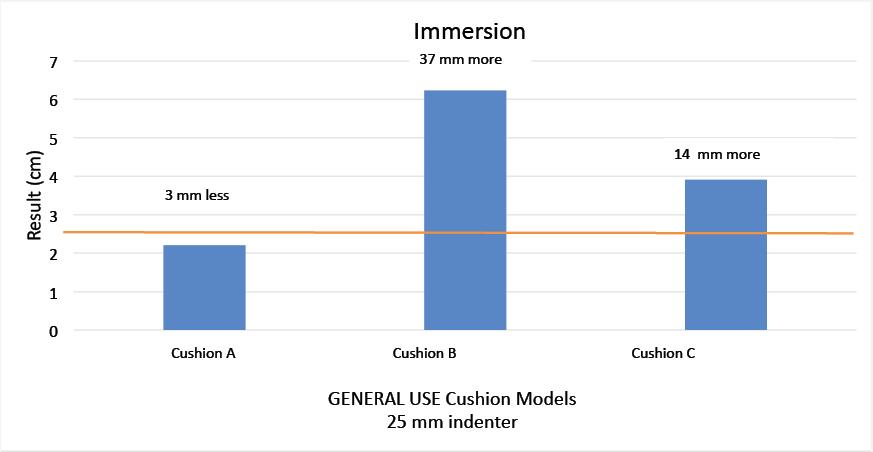

The U.S. Centers for Medicare and Medicaid Services recognized the value of the immersion test and adopted a version of the ANSI/ RESNA and ISO method as a coding and reimbursement requirement. In this regulatory application, there are firm pass/fail limits. Cushions coded as “general use” must reach an immersion of 25 mm or greater to pass the immersion test with a 25 mm indenter, and those coded as “skin protection” must reach an immersion of 40 mm or greater to pass with the 40 mm indenter (see Figures 4 and 5). As noted in the CPG, you can find a wide variety of support surface choices on the market, and their characteristics and performance can vary. You can
see from the University of Pittsburgh’s data that not all cushions meet the thresholds for their U.S. Medicare classifications, whether general use or skin protection.
While immersion is important, it only tells us how deeply the body potentially sinks into the cushion - it doesn’t tell us how well the cushion fits to the body to fully support it. Just from the standpoint of basic physics, we want to maximize the contact and support between the body and the cushion to reduce pressure as much as possible. This is referred to as envelopment. Pressure mapping gives us some idea of envelopment by measuring contact area, but the pressure mat itself is somewhat rigid and prevents a true picture of envelopment from emerging.
To remove the effect of the pressure mat, the ISO standards committee developed a test method that utilizes a curved apparatus to simulate the shape of the buttocks, ISO 16840-12 [3] (see Figure 6). The surface has numerous holes across the full curved surfaces, which house small sensors that take direct pressure readings, without a separate, interfering pressure mat. By looking at the data from the sensors, we have an idea of how the forces of the body are managed by the cushion, and whether the cushion evenly distributes the load in the pelvic area, or partially or fully offloads. Additionally, the sensors are precise laboratory grade components, which can provide more reliable data than traditional pressure mapping systems.
The CPG talks about cushion construction achieving pressure redistribution by either immersion and envelopment or redirection and offloading, so the ISO standard provides an objective laboratory bench test for evaluating the ability of a cushion to achieve these goals.

Test results from the University of Pittsburgh demonstrate the difference in the way two cushions distribute the simulated body weight. Cushion A data demonstrates fairly evenly supporting the body across this centerline (the line graph), which is the same centerline region used in the immersion test. Cushion B has peak pressures at both ischial tuberosities, with one being even higher than the other. That’s important to understand because the ischial tuberosities are vulnerable to pressure injury, and peak pressures should be avoided here. This is new information that is not revealed by the immersion test alone.
The colored bar charts represent the average of the sensors in the colored zones mapped in the indenter above and provide another look at the way the simulated body is supported by the cushion (see Figure 7).


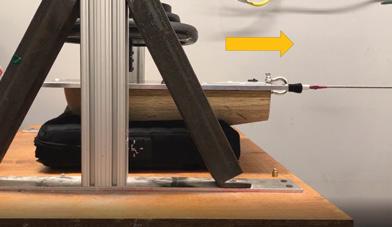
The CPG is clear about how shear forces at the interface between the body and a support surface can exacerbate internal tissue deformation, leading to pressure injuries. It’s not just about the overall, external pressure from the normal/downward forces - the forces involved when someone is seated are actually very complex and multi-directional with compression, shear and tension all distorting the tissues. Support surfaces should minimize those deformations as much as possible, so while it is important to reduce the external pressure on the body, minimizing the shear forces at the interface is also a key clinical goal.
While shear forces are reduced by the cushion/cover design, it is also important to understand if any other seating goals are compromised. For example, it’s easy to visualize a very slippery surface that might be good for the tissues but might be too slippery for the client to maintain their posture in the chair. This is where the horizontal force test comes in.
Like in other ISO protocols, the horizontal force test described in ISO 16840-2 [3] includes a weighted, buttock-shaped rigid indenter, placed on a cushion (see Figure 8). A cable pulls the indenter forward, and the force it takes to move the indenter is measured. More force to pull the indenter may indicate the person will be fairly secure in their posture, while less force may indicate a tendency to slide forward.
CONTINUED ON PAGE 36
FIGURE 6 FIGURE 7 FIGURE 8THE FORCES INVOLVED WHEN SOMEONE IS SEATED ARE ACTUALLY VERY COMPLEX AND MULTI-DIRECTIONAL WITH COMPRESSION, SHEAR AND TENSION ALL DISTORTING THE TISSUES.Curved apparatus to simulate the shape of the buttocks.* Colored bar charts represent the average of the sensors. +
To enhance this test, the University of Pittsburgh added a shear sensor beneath the simulated ischial tuberosities to get a localized shear force measurement in an area we know is vulnerable to pressure injuries (see Figure 9). High shear forces indicate the tissues may be tugged and distorted more, and low shear forces indicate less tugging.
In the test results (see Figure 10), a cushion was tested for shear and horizontal force, with a standard cover and with a cover that was intended to reduce interface shear forces. With the standard cover (Cover A), the shear values increased as the indenter was moved forward from 0-20mm. With the “low shear” cover (Cover B), the shear force was dramatically reduced. It appears the cover was accomplishing what it claimed.
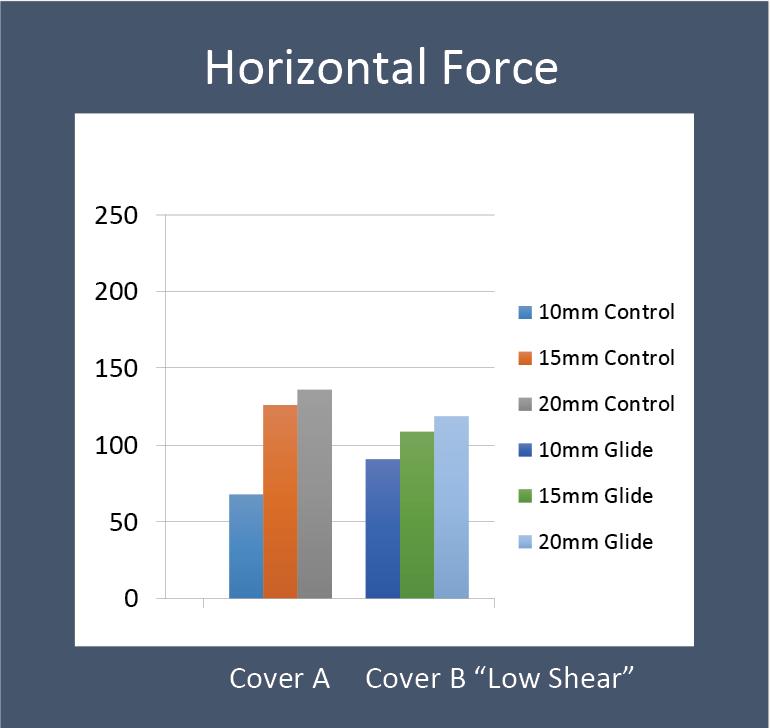

The horizontal force test was then applied to the cushions with covers A and B, and the indenter was moved again. The results from the horizontal force test were very similar (see Figure 11).
The takeaway from both tests is that the low shear cover, Cover B, did appear to lower the shear forces at the interface without compromising the user’s ability to stay put in the cushion, potentially avoiding the effect of sliding forward. The claim has support from objective bench-testing data.

The CPG defines microclimate as the temperature, humidity and air flow next to the skin surface. Measuring temperature and humidity gives an indication of how the skin’s natural cooling processes might be affected by the cushion and cover. When the skin is too moist, it’s more vulnerable to tears and breakdown, and when the skin is too dry, it’s also vulnerable. While the CPG notes that microclimate plays
MEASURING TEMPERATURE AND HUMIDITY GIVES AN INDICATION OF HOW THE SKIN’S NATURAL COOLING PROCESSES MIGHT BE AFFECTED BY THE CUSHION AND COVER. WHEN THE SKIN IS TOO MOIST, IT’S MORE VULNERABLE TO TEARS AND BREAKDOWN, AND WHEN THE SKIN IS TOO DRY, IT’S ALSO VULNERABLE.AN OVERVIEW OF ISO... (CONTINUED FROM PAGE 35) Shear sensor * Shear force test results. +
a role in the development of pressure injuries, it also notes that the “characteristics of an optimal microclimate are still a matter of debate and ongoing research.” For this reason, along with the intrinsic risks individuals have, the ISO standards for microclimate (ISO 16840-7 draft standard and ISO 16840-11) [3] are useful for comparing cushion performance, but pass/fail requirements have not been set. A rigid indenter was designed specifically for this testing.

The University of Pittsburgh applied ISO 16840-7 to a wheelchair cushion with different cover options. The takeaway in this case was that the microclimate covers did reduce humidity but did not reduce temperature (see Figure 13).

While many of the seating standards were created with tissue integrity in mind, the positioning and stability of the wheelchair user should also be considered. In 2021, ISO 16840-13 was published to provide a measure of lateral stability [3]. This method uses the rigid indenter, which is centered and leveled on the cushion. A weight is applied, then shifted to the side, and the resulting angle is measured (see Figures 14 and 15). The amount the cushion tips in response to this shift gives an indication of how a cushion might react to a person leaning or reaching to the side. We cannot draw exact conclusions, of course, since a person’s real-life movements are more complex, but this test allows us to objectively compare this mechanical characteristic across cushions.

CONTINUED ON PAGE 38
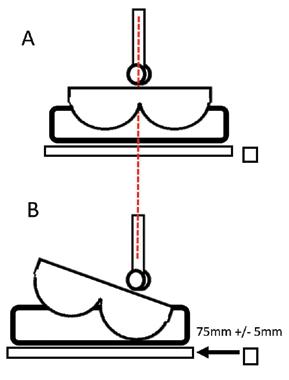 FIGURE 14
FIGURE 13
FIGURE 15
Microclimate test results +
Lateral tilt testing *
Lateral tilt testing *
FIGURE 14
FIGURE 13
FIGURE 15
Microclimate test results +
Lateral tilt testing *
Lateral tilt testing *
WHILE MANY OF THE SEATING STANDARDS WERE CREATED WITH TISSUE INTEGRITY IN MIND, THE POSITIONING AND STABILITY OF THE WHEELCHAIR USER SHOULD ALSO BE CONSIDERED.
The University of Pittsburgh applied this test to numerous wheelchair cushions, measuring the tilt angles, which is shown by the height of the blue bars in the chart in Figure 16.
The data gives some indication of which cushions might be more stable than others, and it also reveals that the material of the cushion doesn’t guarantee a stable surface. When cushions were categorized broadly by “foam, gel or hybrid” or “air,” results occurred across the spectrum, from the most stable at just over 1 degree of tilt, up to the greatest amount of tilt at about 6 ½ degrees. Every cushion is different, and every manufacturer has a different design intent and approach.
This testing was repeated with pressure mapping to understand how the stability was achieved and potential compromise to pressure management while in the tilt position. Pressures measured during the tilt were graphed in yellow and overlaid on the tilt results (see Figure 17).

Two of the cushions that were the most stable, on the left side of the graph, had the lowest amount of tilt but the highest peak pressures, essentially pushing back on the indenter. The third cushion from the left was still very stable and maintained a low peak pressure, so this

cushion looks like a “best of both worlds” option. When a quick lean is performed, and the person returns to center, this feature may not be critical. However, with clients who cannot reposition themselves and may find themselves leaning to one side for a long period of time, stability and pressure management in a lean may both be critical characteristics.
Historically, flammability tests for furniture have been applied to wheelchairs, involving application of a burning cigarette or an open flame and then testing whether flames self-extinguish within a given time and examining the “burn pattern.” These tests have poor repeatability, but more importantly, they were developed for furniture and not medical devices. Sofas have no “clinical benefit,” for example, while wheelchair seating, as a medical device, is intended to support the person and protect their tissues from injury, first and foremost.
In fact, some materials used to reduce fire risk may compromise management of tissue loads and microclimate, as noted by the CPG. Additionally, the use of flame retardants often involves the use of chemicals that can be hazardous to health, and in fact, there is a global trend to eliminate open flame testing and the use of flame retardants in the consumer products industry.
The ISO committee analyzed these factors with a risk and benefits approach, while considering the probability of harm. International data revealed that the historic occurrence of flame-related events and injuries was extremely low. Alternately, the risk, severity and occurrence of pressure injuries is very high for wheelchair users, and wheelchair seating should be designed to reduce this risk as much as possible.
As a result of this analysis, a simulated electronic cigarette was developed as a test for all “soft surfaces” of wheelchairs (ISO 1684010:2021) [3] (see Figure 18). Use of the ISO 16840-10 standard is specifically supported by the CPG.
When open flame testing is removed as a regulatory requirement, designers will no longer be restricted to the use of flame-retardant materials. This will open the door to significant innovations, utilizing materials that can optimize wheelchair seating for better immersion, envelopment, shear reduction and microclimate management, as well as accommodating smart textiles, all of which will benefit the wheelchair user.
With this article, we wanted to highlight several of the published ISO standards for wheelchair seating and place them in the proper context of the clinical reasoning process. There are, of course, many more standards that apply to mobility solutions for power and manual wheelchairs and components. We chose to focus on standards related to wheelchair seating, and the clinical practice guideline for prevention of pressure injuries.
As the therapist considers all the needs of the client, ISO test results can provide additional guidance, especially as a complement to the CPG for pressure injury prevention. The therapist can prescribe cushions with confidence, knowing their decisions are supported by state-of-the-art clinical practice and international test standards.
Experts from many settings and disciplines collaborated to create these methods, including clinicians, engineers, researchers and public policy officials, and there is much more work to be done. Kelly Waugh, MA, PT, who is very active on the ANSI/RESNA and ISO wheelchair cushion standards committees said it best, “These standards are created by us and for us.”
If you wish to join these important, life changing efforts, we would love to have your involvement!
Kara may be reached at KARA.KOPPLIN@PERMOBIL.COM
* IMAGES PROVIDED BY THE UNIVERSITY OF PITTSBURGH TISSUE INTEGRITY MANAGEMENT LABORATORY

+ DATA PROVIDED BY THE UNIVERSITY OF PITTSBURGH TISSUE INTEGRITY MANAGEMENT LABORATORY

FOR MORE INFORMATION:
HTTPS://GUIDELINESALES.COM/PAGE/GUIDELINES
HTTPS://CDN.YMAWS.COM/NPIAP.COM/RESOURCE/RESMGR/EVENTS/ NPIAP_PERMOBIL_WC_SEATING_PO.PDF
HTTPS://WWW.RESNA.ORG/AT-STANDARDS/WHEELCHAIR-AND-RELATEDSEATING-WRS
HTTPS://WWW.ISO.ORG/COMMITTEE/53792/X/CATALOGUE/P/0/U/1/ W/0/D/0
HTTPS://WHEELCHAIRSTANDARDS.PITT.EDU
REFERENCES:
RESNA (2018). RESNA AMERICAN NATIONAL STANDARD FOR WHEELCHAIRS - VOLUME 3: WHEELCHAIR SEATING. REHABILITATION ENGINEERING AND ASSISTIVE TECHNOLOGY SOCIETY OF NORTH AMERICA. ARLINGTON, VA.
2. EUROPEAN PRESSURE ULCER ADVISORY PANEL, NATIONAL PRESSURE INJURY ADVISORY PANEL AND PAN PACIFIC PRESSURE INJURY ALLIANCE. “PREVENTION AND TREATMENT OF PRESSURE ULCERS/INJURIES:

CLINICAL PRACTICE GUIDELINE. THE INTERNATIONAL GUIDELINE.” (2019). INTERNATIONAL ORGANIZATION FOR STANDARDIZATION (ISO). ISO 16840, WHEELCHAIR SEATING – PARTS 1-12. INTERNATIONAL ORGANIZATION FOR STANDARDIZATION. GENEVA, SWITZERLAND.
SPECIAL THANKS TO:
U. PITTSBURGH TISSUE INTEGRITY MANAGEMENT LAB – PROF. DAVID BRIENZA, TRICIA KARG, AND ALEXANDRA DELAZIO PERMOBIL – ANA ENDSJO AND STACEY MULLIS
Kara Kopplin is the director of regulatory science for Permobil. In her role, she is a materials engineer, actively contributing to the efforts of the International Organization for Standardization (ISO) and European Committee for Standardization (CEN) to develop objective test methods for wheelchair systems and components. She is honored to chair the ANSI/RESNA Standards Committee on Wheelchair and Related Seating (WRS) in the U.S.
RESNA’s annual conference will be back, live and in-person, July 1316, 2022, at the Hyatt Regency Hotel in Arlington, Virginia. The theme is “Driving the Future of AT.” By the time this issue has published, the call for conference submissions should be posted on the website. Please consider submitting a session to the RESNA conference and sharing your expertise and knowledge with your colleagues. Conference session types will include 90-minute master classes for advanced practitioners, 60-minute general sessions and 30-minute buzz sessions. The conference session submission site will open on Nov. 1 with a final deadline of Wednesday, Nov. 30. Registration will open in March 2022. We will be following all of the recommended health and safety protocols for COVID-19 during the conference. Hope to see you there!
RESNA’s Professional Standards Board (PSB), under the leadership of Julie Piriano, PT, ATP/SMS, has been hard at work this year with planned maintenance activities for the Assistive Technology Professional (ATP) exam. Earlier this spring, close to 100 ATPs volunteered to participate in new item writing workshops. This summer, the PSB started working on its next Job Task Analysis survey. The JTA subcommittee finishes its work this winter, and the survey will be in the field early next year.
“On deck” for 2022 is a planned update of RESNA’s Seating and Mobility Specialist (SMS) certification. SMS is a specialty certification for professionals working in seating and mobility. While the ATP is a broad-based exam covering all major areas of assistive technology, the SMS exam is focused specifically on seating, positioning and mobility. The program is intended for clinicians, suppliers, engineers and others involved in seating and mobility service provision. The ATP is a prerequisite for the SMS certification. For more information, and to see the exam outline, please visit the certification section of the RESNA website.
At the end of 2020, we reported 4,224 ATPs, which included 382 new ATPs entering the workforce. We are on pace to exceed the amount of new ATPs in 2021, with 319 new ATPs as of Aug. 31, 2021. Our total number of ATPs is now 4,273. The number of ATPs has increased over 5% since 2019, showing not only growth in the industry but also interest from a new generation entering the workforce.
We are fast approaching the end of the year, and that means a high volume of ATP certification renewals. Follow these steps to ensure a timely and hassle free renewal:
• Make sure your RESNA online account is up to date! RESNA recently upgraded its user portal to a new, mobile friendly version. If you have not logged into your RESNA account for a few months, you will need to reset your password. Go to the RESNA website login page, click on “Reset Password,” and follow the prompts.
• Make sure your email is current with RESNA. All communications, including certificate delivery, are through email. We no longer mail physical certificates.
• We recommend that you scan and email your recertification paperwork at least six weeks prior to your certification expiration date. Email your paperwork to certification@resna.org. Do not snail mail.
RESNA’S ANNUAL CONFERENCE WILL BE BACK, LIVE AND IN-PERSON, JULY 13 – 16, 2022 AT THE HYATT REGENCY HOTEL IN ARLINGTON, VIRGINIA...PLEASE CONSIDER SUBMITTING A SESSION TO THE RESNA CONFERENCE AND SHARING YOUR EXPERTISE AND KNOWLEDGE WITH YOUR COLLEAGUES.
• Once the office receives your paperwork, we will place an invoice in your account and email you information on how to pay.
• You may pay securely online using a credit card, or you may mail a check to the address on the invoice.

• We process renewals in order of payment received. Do not delay paying your invoice! Processing may take up to three weeks.
NRRTS staff tells us the number one question asked of them is, what do I need to renew my RESNA certification? NRRTS requires Registrants to renew on an annual basis with documentation of 1.0 CEU of continuing education. Renewal of the RESNA ATP certification is every two years, and requires at least 1.0 CEU of continuing education plus an additional 10 hours. This means those who successfully renew NRRTS Registration meet the requirements to renew their ATP. The only difference is the ATP renewal is every two years.
If you are an ATP, and would like to volunteer for any of the certification activities, please email us at certification@resna.org

Andrea may be reached at EXECOFFICE@RESNA.ORG

 Andrea Van Hook is executive director of RESNA. She has over 20 years of experience in nonprofit association management. She lives and works in the Washington, D.C., area.
Andrea Van Hook is executive director of RESNA. She has over 20 years of experience in nonprofit association management. She lives and works in the Washington, D.C., area.
NRRTS CELEBRATED PURPLE DAY ON JULY 25, 2021, WHICH MARKED FIVE YEARS SINCE WE LOST SIMON MARGOLIS. FOLLOWING ARE A FEW PICTURES FROM THE DAY.
WE MISS YOU, SIMON!
So, this is not going to be a “normal” case study but rather a combination of several cases. Why? Because I am still seeing 10-yearold kids come into my clinic in chairs that are too large, too heavy and poorly designed for their actual needs. So, this article is going to cover two kids who I was lucky enough to start working with when they were very young, and I’m still seeing to this day.
I’m hoping to highlight many of the worries that people seem to have about putting kids in minimal positioning and lightweight pediatric wheelchairs. Plot spoiler ... for the right kids, this is just what they need.
When I first started in pediatrics, I had previously worked with adults following spinal cord injuries, so I was already a bit biased toward rigid lightweight wheelchairs. Additionally, I had the opportunity to work with athletes who use wheelchairs. Many of these athletes had been using a manual wheelchair throughout their lives. These individuals were high functioning, very independent and many had the smallest hip widths I’d ever seen in an adult.
These athletes were the opposite of what I was seeing in my clinic. Older kids seen for the first time in my clinic were mostly overweight and had a low activity level. Was this the natural result of their disability or was it due to their equipment?
Most of these kids were in folding frame wheelchairs that, despite five years of use, were still at least an inch too wide. The center of gravity was often so far back that the child couldn’t effectively propel the wheelchair. Add on heavy positioning equipment that wasn’t really necessary, and the wheelchairs were difficult for these kids to propel. With a chair that hard to propel, it makes sense that these kids would prefer to be sedentary. I know I would have made that choice (everyone who knows me knows how true that is)!
Twenty-two years in my clinic have shown me that it is not likely to be nature leading to these sedentary tendencies. I work with a great cohort of kids who have been active and remained at an appropriate weight / body mass. Do all of these kids live in families with strong follow-through? Some do, others don’t. Do I spend a lot of time telling the families about future implications to current activity levels? Absolutely! I know that makes some difference, but my telling a family about the importance of wheelies and participating in sports can’t be the only reason these kids are at an appropriate weight and are more active.
So, could it be the wheelchair style and set-up? I think it could! Here are a few examples:
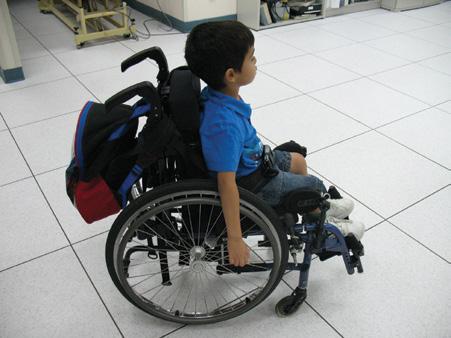
JOSH:
Josh is a great young man with a complex medical history including C6 quadriplegia secondary to transverse myelitis, diabetes, a mitochondrial disorder and seizures. I didn’t meet Josh until he was 5. At the time, he was in a wheelchair that was too large and too heavy for him, and he was having a hard time propelling. (Full disclosure, he was seeing a doctor next to my office, and I saw him. I told his mom that I needed to see him and help. Yes, I have been known to stalk kids in my clinic.)
Josh’s original wheelchair weighed well over 45 pounds, and he only weighed 37 pounds at the time. He had a heavy planar back and a head support that his head never touched. The wheels were set about 3 inches further back than they should have been. He had no seat slope at all, so he tended to slide forward in the chair (see Figure 1).
We took Josh out of that chair and got him into a lightweight rigid frame pediatric wheelchair with lighter seating components and no head support. This chair also had a much more appropriate center of gravity and seat slope. The seat width was much closer to his sitting width (see Figure 2). It was also almost 20 pounds lighter than his old chair!
Once in the new chair, Josh was much more active. He started propelling more and did not want others pushing him. Whenever he would come to our clinic to see his doctors, he’d spend a lot of time going up and coasting down the ramp to my office.
Over the years, Josh has had a couple of new chairs. All have been configured tightly to him. He had a hip width of 10.5” in 2013, and his new chair was set at 12” seat width. In 2018, his hip width had only increased to 12.5”, and we set his seat width at 14”. All have lasted the recommended five years with minimal growth and adjustment over that time. I just saw him a week ago, and he’s still got plenty of room in his seat width. Truthfully, most of the work done has been to fix his chairs as he is really active and a little hard on his equipment.
Josh likes tearing up chairs so much that he now plays wheelchair rugby (see Figure 3). He loves it, and he’s learning a lot from the guys on his team (some good, some bad, but what can you do?). He’s done martial arts from his chair over the years as well.

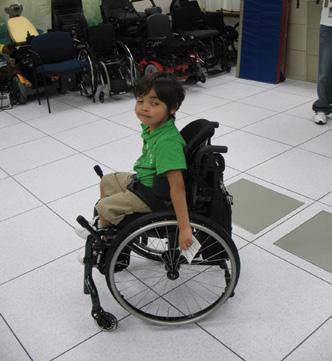
Despite a few medical setbacks, Josh is now a 15 year old who is fully living his life (see Figure 4). He does what he wants to do, and he is getting ready to get his learner’s permit this year. He knows that he can load his chair into the car by himself once he is driving. Nothing is slowing him down from achieving what he wants to do in life!
CONTINUED ON PAGE 44
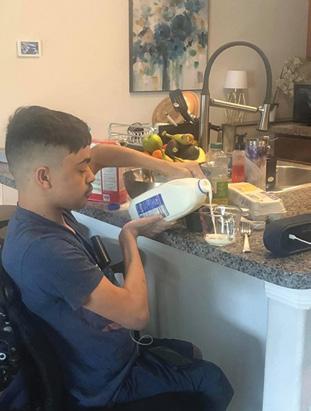 FIGURE 2
FIGURE 3
FIGURE 4
Josh in his first new chair from my clinic. Note the center of gravity..
Josh in his rugby wheelchair.
Josh making breakfast for his family.
FIGURE 2
FIGURE 3
FIGURE 4
Josh in his first new chair from my clinic. Note the center of gravity..
Josh in his rugby wheelchair.
Josh making breakfast for his family.
“HE DOES WHAT HE WANTS TO DO, AND HE IS GETTING READY TO GET HIS LEARNER’S PERMIT THIS YEAR. HE KNOWS THAT HE CAN LOAD HIS CHAIR INTO THE CAR BY HIMSELF ONCE HE IS DRIVING. NOTHING IS SLOWING HIM DOWN FROM ACHIEVING WHAT HE WANTS TO DO IN LIFE!”
LYLA
I first met Lyla when she was 2 years old. She was a spunky young lady and that has not changed in the time that I’ve known her. Lyla has spina bifida and has very little lower extremity movement, so she will likely be a wheelchair user throughout her life.
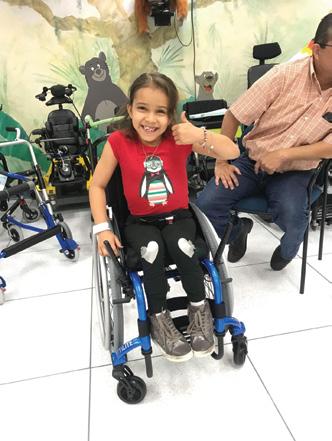


During our first appointment, I put her into one of my clinic chairs, and she just took off. Even without a perfect fit, she was moving herself around and loving the independence. She was so sad when she left that day without a chair. However, a month later (yes, it only took a month to get the chair approved and ordered), she was back in my office getting her hot pink chair.
As you can see from the pictures, we did not put much extra seat width in the chair so that she felt stable and she could reach the wheels effectively (see Figures 5 and 6). She loved the color and the independence and hasn’t stayed still since then.
Many professionals look at her in the initial chair and panic.
“There is no room for her to grow without having to actually grow the frame.”
“She’s two and she’s going to have the chair until she’s 7; she’s going to grow out of the frame and you’re going to be stuck.”
Guess what? None of that happened. She came back to see me five years after getting the original frame, and it was a little small, but it was fine. She never totally grew out of it. At 2, she has a hip width of 8”, and at 8, she had a hip width of 10.5”. So, a chair that had a seat width of 9”-11” was just fine and never caused problems.
So, after five years we got her a new blue chair. This one took a month and a half from evaluation to delivery. As you can see, the new chair is also fitted tightly to her
“DURING OUR FIRST APPOINTMENT, I PUT HER INTO ONE OF MY CLINIC CHAIRS AND SHE JUST TOOK OFF. EVEN WITHOUT A PERFECT FIT, SHE WAS MOVING HERSELF AROUND AND LOVING THE INDEPENDENCE.”Front view of Lyla on delivery day for her first wheelchair. Side view of Lyla on delivery of her first wheelchair.
(see Figure 7). And, if you look two years after getting the chair, she still fits just fine in the chair (see Figure 8).
During all this time Lyla has been an active young lady. She goes everywhere her family goes. It is very rare that she asks for or will allow others to push her chair. She dabbles in some wheelchair sports activities as long as they don’t mess up her nails too much (see Figure 9).
What can be learned from Lyla?
Configuring a wheelchair to facilitate function from the start has made her an active kid with very few limitations. In five years, she grew 12 inches taller and gained 16 pounds. She has remained at an appropriate weight because she has stayed active.
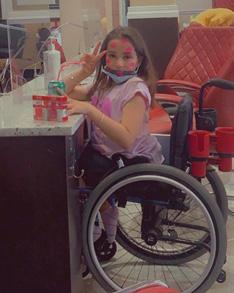

I could bore you with stories about Charlie, Theo, Rynon, Natalie, Dahlia, Jazlynn and many other kids who have similar stories to the two above. Unfortunately, I have a word limit so I can’t share all of them here.
The thing that all these kids have in common is that I started with them early (some at just over 1 year of age). All went into the lightest weight rigid manual wheelchair available at the time they received their first, second and, in some cases, third chairs. Some have solid backs and lateral supports while others have basic upholstery backs. All had a seat width no more than 1.5” wider than their hip width, an appropriate seat slope and as forward of a center of gravity as the child could safely propel. Each child was individually evaluated sitting on my mat table to decide what they truly needed to be successful operating their wheelchair. No one has equipment on their chair that was not medically needed, yet all were allowed on the school bus without head supports or anterior trunk supports (that’s a much longer conversation than we can have here, but just know I’ve convinced many school bus drivers that these chairs are safe).
By providing this kind of wheelchair with the proper set-up, all of these children have viewed their chairs as enabling devices and have been very active in them. Not all participate in sports but they all play with friends, go to the mall, get their nails done and do what makes them happy without feeling limited. While living their lives and being active, they have all maintained a low body fat percentage (BMI) and no one has needed a chair replaced before a five year time frame.
So, please look at the kids you work with and make sure you are setting them up for success. An “OK” chair is not good enough. We can achieve a longterm impact by teaching children and their families that the chair is not a pain or limitation. Properly designed pediatric lightweight wheelchairs teach kids that they have no limits. At the end of the day, isn’t that what we want to see?
Lauren may be reached at PTLAUREN@AOL.COM
Lauren Rosen, PT, MPT, MSMS, ATP/SMS, is a physical therapist
St. Joseph’s Children’s Hospital in Tampa, Florida. She is the program coordinator for the Motion Analysis Center, a three-dimensional motion analysis lab, where she also manages a pediatric and adult seating and positioning clinic. She has written a number of RESNA position papers on both powered and manual wheelchairs. She writes articles for NRRTS, and she is on the editorial board for Mobility Management. She lectures nationally and internationally on pediatric and adult wheelchairs as well as the importance of standing. She has been active in DME prescription for over 25 years. She is a past member of the RESNA Board of Directors. In her free time, she can be found on the nearest mediation cushion.
 FIGURE 9
FIGURE 8
Lyla, 2 years after receiving her second wheelchair.
FIGURE 9
FIGURE 8
Lyla, 2 years after receiving her second wheelchair.
Tilt in space is a feature on mobility bases such as adaptive strollers, manual wheelchairs and power wheelchairs. The orientation of the client changes in relation to the ground without a change in the seated angles. Tilt may move posteriorly, anteriorly or laterally. Tilt is sometimes combined with other technologies, such as recline.
POSTERIOR TILT:
A client may benefit from a posterior tilt to redistribute pressure from the buttocks and posterior thighs to the posterior trunk and head, shifting weight to reduce pressure injury risk. Posterior tilt can also be used to manage posture by reducing the impact of gravity on the seated position and subsequently reducing the effort required to keep the trunk and head upright. Tilt helps to manage fatigue by also reducing the client’s effort to stay upright and even allowing sleep while seated. Finally, posterior tilt may be used to manage medical concerns, such as the postictal stage following seizure activity.
ANTERIOR TILT:
Anterior tilt has more specific clinical indicators. By tilting the entire seating system forward, the client is placed in a ”task performance” position, which facilitates a slight anterior pelvic position, upper extremity function, and increases trunk and head control. However, this is a difficult position to maintain, and the client must return to a more traditional seated position or even a posterior tilt to find a position of rest.
If a client has significantly limited hip flexion, the seat-to-back angle will have to be quite open to accommodate this range limitation without pushing the pelvis into a posterior tilt. This position is not very functional and may impact vision. By using an anterior tilt, the client can approach a more upright trunk while respecting the limitation in hip flexion. In this case, the pelvis is more prone to slide forward during the anterior tilt, and sufficient postural supports are required.
A true anterior tilt does not open the seat-to-back angle; however, some newer power seating functions incorporate an anterior tilt, which actually opens the seat to back angle by raising the posterior portion of the seating surface.
LATERAL TILT:
Some clients are unable to tolerate a posterior tilt or recline to shift their weight. When the head moves posterior to upright, reflexive responses (i.e., startle) and postural insecurity can occur.
Another strategy to provide a weight shift is a lateral tilt, only available on power wheelchair bases. In this case, the entire seating system tilts to one side, relieving pressure under one ischial tuberosity at a time. During the weight shift, the client may have difficulty sustaining an upright seated posture and experience increased pressure against the lateral trunk support on the low side.
Lateral tilt is sometimes used to accommodate a significant pelvic obliquity. In most cases, a lateral wedge under the seat itself is sufficient, rather than a powered lateral tilt.
Tilt features on mobility bases have many clinical advantages and should be considered as a part of seating and mobility equipment recommendations.
Michelle may be reached at MICHELLELANGE1@OUTLOOK.COM
REFERENCES
1. DICIANNO, ET AL. (2015). RESNA POSITION ON THE APPLICATION OF TILT, RECLINE, AND ELEVATING LEGRESTS FOR WHEELCHAIRS LITERATURE UPDATE. HTTPS://WWW.RESNA.ORG/PORTALS/0/DOCUMENTS/ POSITION%20PAPERS/RESNA%20PP%20ON%20TILT%20RECLINE_2017.PDF.
Michelle Lange is an occupational therapist with more than 30 years of experience and has been in private practice, Access to Independence, for over 10 years. She is a wellrespected lecturer, both nationally and internationally and has written numerous texts, chapters, and articles. She is the co-editor of “Seating and Wheeled Mobility: A Clinical Resource Guide,” editor of “Fundamentals in Assistive Technology, Fourth Edition,” NRRTS continuing education curriculum coordinator and clinical editor of DIRECTIONS magazine. Lange is a RESNA Fellow and member of the Clinician Task Force. Lange is a certified ATP, certified SMS and is a senior disability analyst of the ABDA.

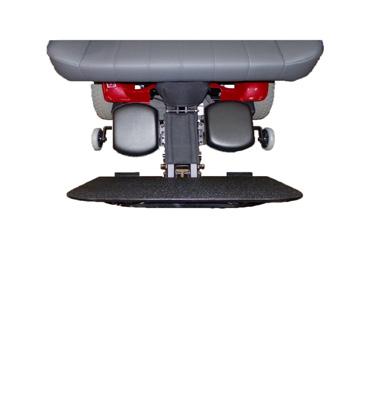
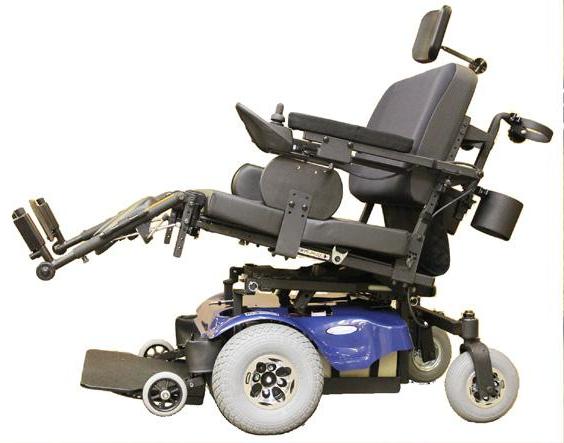
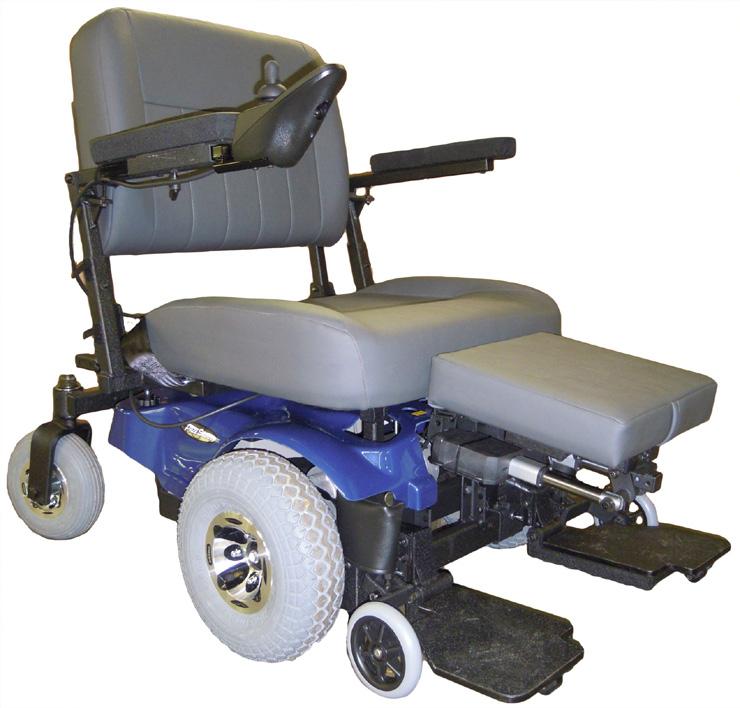

Many seat size options:
Seat bases offered in widths from 16” to 38”; depths from 14” to 26”
Flip-up, removable, adjustable arms
Numerous custom options offered:


Special calf pads - Custom-size Footrests - Power ELRs
Power Anti-tips Stomach & Amputee supports-Power or Manual
I never got to be a candy striper, but after visiting the local hospital where I would later take over the retired OT’s job, I fell in love with the idea of helping people get back to living, often using arts and crafts as that venue. Occupational therapy has come a long way since those days, but that experience solidified the need to look at the whole person, whole body and help clients become functional and have a sense of person again.
I graduated in 1982 as an occupational therapist from the University of Western Ontario, hoping to work with clients with hand injuries. After a few years at various jobs, I worked as the sole occupational therapist at my hometown hospital in Simcoe, Ontario. This position helped me hone my OT skills. It taught me to be independent in decision-making. I also realized I liked working with clients in wheelchairs, adjusting the chairs to make them fit and function better.
The pink and white uniform of a candy striper volunteer at the local hospital may have first attracted Sheila Buck to the health care field. However, her mother had the most prominent influence on the occupational therapist’s (OT) career. “My mother, Ruth Ramp, greatly influenced me and the choices I made through life. She was born with a disability and did not have the same choices in life that an ablebodied person would have,” Buck said. “These circumstances framed her life and her choices and limited her ability to have life experiences that she may have chosen otherwise. However, the greater lesson from this was her courage, her resolve and her capacity to raise four children and work on a farm as a farmer’s wife. My mom worked within her abilities and was stronger than most people because of her need to adapt and live with pain and limited mobility.”
I later moved to a position as the prime therapist at the chronic care unit of the Credit Valley Hospital in Mississauga, Ontario. While there, an RTS noted I was “good at using the wrench” and adjusting chairs and suggested that I become a sales rep for a wheelchair supplier. That comment changed my life as I jumped at the opportunity to be even more “hands-on” with clients. For the next 10 years, I worked for the two largest wheelchair suppliers. in Southern Ontario at that time, Therapy Supplies and Motion Specialties.

During my time as a sales rep, I realized a great need for educational services for the therapist population above and beyond what was available. I began offering workshops designed specifically for therapists relating more to hands-on clinical measuring and prescription of wheelchairs.
After leaving my responsibilities as a sales rep, I spent a brief, one-year dabble into insurance work which reinforced how much I would rather work with my wheelchair clients! At this point, I took a deep breath and started my own company, Therapy NOW! (NOW standing for new opportunities for well-being with the exclamation mark noting that it is imperative.) Initially, my focus was on wheelchair consultations and education, but a keen awareness of the need for ongoing, practical instruction for therapists, especially in remote areas, led me to develop my “Back to Basics and Beyond” workshop.
My first workshop was in my hometown, and I was fortunate to have my parents attend the first day. It was wonderful to have their support, plus they had always had a hard time understanding what I did in my job (as most OTs have experienced). My parents also couldn’t fathom how I could talk for two days about a wheelchair. At the end of that first day, my mother, who had to rely on mobility devices for 50 years of her life, declared she now understood that “wheelchairs were more than four wheels” ... She got it!
After working in my practice for 22 years, providing wheelchair consultations and prescriptions across Ontario, I retired from clinical practice in 2019. However, I continue to offer educational webinars, seminars and workshops across the globe in private practice settings for national and provincial OT associations, private OT groups and university students looking for more information in the complex rehabilitation area of assistive devices. With much encouragement from colleagues, in 2009, I wrote a clinical book (revised in 2017) on prescriptive pathways for seating and mobility. I used my mother’s comment for the title, “More Than Four Wheels: Applying clinical practice to seating, mobility and assistive technology.” The book is used worldwide in clinical practices, universities and for RTS and manufacturer training.
I love working with my clients! It is wonderful to see the smile on their faces when clients realize their new chairs and seating allow them to engage in more activities and focus on living rather than on inability or pain. This experience was even more powerful when I worked as a volunteer in Haiti and Uganda through Team Canada Healing Hands and the Walkabout Foundation. In those circumstances providing even the most fundamental mobility and seating needs brought a life to those individuals they never thought possible. I’m also motivated by the understanding that education is not just about training new therapists. It is also about helping clients and caregivers understand why seating and mobility are paramount for living life to its fullest.
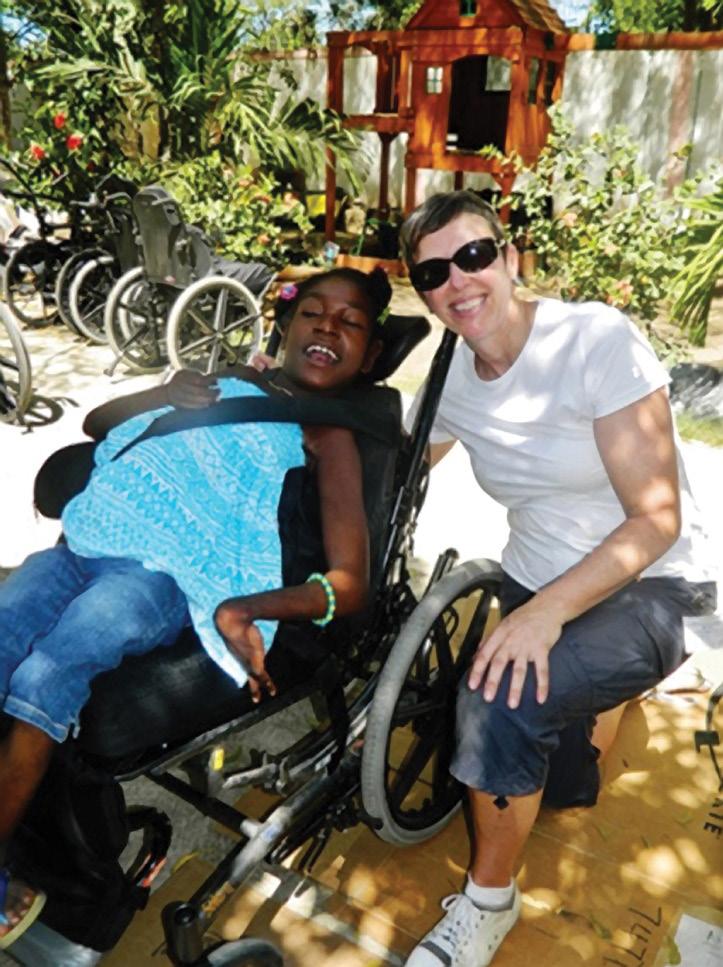
My grandsons are possibly my greatest inspiration. Ben, who is 8 years old, lives with Down syndrome and faces daily challenges head-on. He barrels through life with his head high and his smile wide. His younger brother, Charlie, who is 5 years old, inspires me daily when I see his love and compassion for his brother. Charlie possesses an innate ability to know when Ben needs help and quietly guides him without missing a beat.
CONTINUED ON PAGE 50
“I LOVE WORKING WITH MY CLIENTS! IT IS WONDERFUL TO SEE THE SMILE ON THEIR FACES WHEN CLIENTS REALIZE THEIR NEW CHAIRS AND SEATING ALLOW THEM TO ENGAGE IN MORE ACTIVITIES AND FOCUS ON LIVING RATHER THAN ON INABILITY OR PAIN.”
WHEELCHAIRS ARE MORE...
(CONTINUED FROM PAGE 49)
Get to know your client! Unfortunately, some therapists get caught up in policies, time restraints and funding first rather than listening and hearing what the client is saying. Understanding body mechanics and the physics of mobility, stability and posture are essential but don’t forget about the art of emotion, family life, function and the personal experiences of your client.
The most prominent memory I have from my career is not about the number of chairs I sold or the new techniques I used. Instead, it is of a 19-year-old man who lost his “whole world,” meaning his girlfriend, hobbies and life plans, when he suffered a spinal cord injury from a snowmobile accident. He had a chip on his shoulder and hated life. As we worked through his needs and got him mobile, we also discussed a standing frame. He resisted the idea but eventually agreed to give it a try. Once set up and standing, I looked up at him and saw tears running down his face. When I gently asked him what was going on, he stated, looking down at his hands, ‘“That’s the first time I’ve been able to put my hands in my pockets since my injury.” We must remember that the little things count and not always what we, the therapist or RTS, think is important.
First and foremost, I love spending time with my family and friends, and now, after our experience with COVID-19, I appreciate every moment together I can get.
I have a wonderful family: three sons, two daughters-in-law, two grandsons and my wonderful husband of three years, who has two sons and a daughter. All of our children are independent and live their lives in Ontario and across three U.S. states. I can’t miss mentioning my cat and step-dog who have also learned to become family and give me great laughs when they vie for affection ... jealousy 101!
I have recently taken up golf for fun and as a form of outdoor exercise. Growing up on a farm reinforced my love of nature, and I spend as much time as I can outside gardening, walking, recreational biking and, more recently in the summer, paddle boarding on Lake Erie. Now that I’m semi-retired, I hope to spend more time doing photography and some pencil and paper drawing. My mother was an artist, and I

“THE MOST PROMINENT MEMORY I HAVE FROM MY CAREER IS NOT ABOUT THE NUMBER OF CHAIRS I SOLD OR THE NEW TECHNIQUES I USED. INSTEAD, IT IS OF A 19-YEAR-OLD MAN WHO LOST HIS “WHOLE WORLD” ... WHEN HE SUFFERED A SPINAL CORD INJURY FROM A SNOWMOBILE ACCIDENT.”
PRESIDENT - Gerry Dickerson, ATP, CRTS®
PRESIDENT ELECT - Carey Britton, ATP/SMS, CRTS®
VICE PRESIDENT - Tom Simon, ATP, CRTS®
TREASURER - Andrea Madsen, ATP, CRTS®
SECRETARY - Jason Kelln, ATP/SMS, CRTS®
US REVIEW CHAIR, DMAC A - Mike Harris, ATP, CRTS®
US REVIEW CHAIR, DMAC B - Doug Crana, ATP, CRTS®
US REVIEW CHAIR, DMAC C - Mike Seidel, ATP, CRTS®
US REVIEW CHAIR, DMAC D - Brian Coltman, ATP/SMS, CRTS®
AT-LARGE DIRECTOR - Tim Robinson, ATP/SMS, CRTS®
AT-LARGE DIRECTOR - David Nix, ATP, CRTS®
AT-LARGE DIRECTOR - Chris Savoie, ATP/SMS, CRTS®
AT-LARGE DIRECTOR - Stefanie Laurence, RRTS ®
feel I have a bit of an artist’s “eye,” but I will have to see how it comes out on paper!! Living in wine country (Niagara on the Lake, Ontario) also provides me with many opportunities to explore wineries, the Niagara Escarpment and all this area must give. On rainy or snowy days, I love a good book! I am also a competitive and determined person who strives for perfection in myself and others. My goal is to learn to chill, relax and understand more and more that sometimes what is, is, and it’s okay!
Sheila may be reached at SHEILABUCK11@GMAIL.COM.
Sheila Buck, based in Niagara on the Lake, Milton, Ontario, Canada, is an occupational therapist and president of Therapy NOW Inc., providing education and consultation, assessment, and prescription regarding assistive technology. Buck’s book, “More than Four Wheels: Applying clinical practice to seating, mobility and assistive technology” is available www.sheilabuck.ca

CA REVIEW CHAIR, REGION A - Darrell Mullen, RRTS ®
CA REVIEW CHAIR, REGION B - Michelle Harvey, RRTS ®
CA REVIEW CHAIR, REGION C - Bernard “Bernie” Opp, RRTS ®
ELAINE STEWART, ATP, CRTS® - Past President
MIKE OSBORN, ATP, CRTS® - Past President
MICHELE GUNN, ATP, CRTS ® - Past President
JOHN ZONA, ATP, CRTS ® - Past President
DENISE HARMON, ATP, CRTS ® - Past President
MIKE BARNER, ATP, CRTS ® - Past President
SHEILA BUCK, B.SC.(OT), REG. (ONT.)
STEVE CRANNA
MICHELLE HARVEY, BSC HONS OT
MIKE LONGO
LINDA NORTON, M.SC.CH, PHD, OT REG. (ONT.)

JASON KELLN, ATP, CRTS®
EXECUTIVE DIRECTOR – Weesie Walker, ATP/SMS
DIRECTOR OF OPERATIONS – Amy Odom, BS
DIRECTOR OF EDUCATION – Annette Hodges, MA, BS
DIRECTOR OF MARKETING – Bill Noelting
CONTINUING EDUCATION CURRICULUM COORDINATOR –Michelle L. Lange, OTR/L, ABDA, ATP/SMS
CONSUMER RELATIONS & ADVOCACY – Andrew Davis
Sheila’s mom and dad, Ruth and William Ramp, with her grandson, Ben.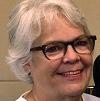
Working in the field of assistive technology has been rewarding in so many ways. From the first experience of seeing a child be able move about independently in his environment, I was hooked!
When I began this odyssey, RESNA and NRRTS did not exist. Some of my education came from the clinicians I worked with and the manufacturers who brought in pizza while they demonstrated the equipment.
The best education came from the clients I served. They gave me the real scoop on how the technology fit their lifestyle. It was too heavy! It was not comfortable! Transfers were difficult. Many times, we would need to modify, change or start over. Did we always get it right? NO! There was always something to learn to improve service for the next person.
As seating and mobility began to gain more attention, there were opportunities to get education specific to appropriate positioning. Clinicians were presenting courses on postural support. The first Medtrade in Atlanta offered a whole day with Adrienne Bergen teaching how to measure, how to support and how to build a system out of tri wall (fancy name for cardboard). Being part of this was empowering. I met other people with a common passion. There was no name for what we did, but that didn’t matter. We gathered in groups sharing experiences, good and bad. It was a happening!
The first Seating Symposium in Memphis was even more remarkable in all it offered. As I look back, I can see how this formed my path to today. Bergen’s course was on my list. She told us about a meeting to learn about the formation of an organization for suppliers. Count me in! I met Simon Margolis and listened to
him talk about the need to recognize people who specialized in seating and mobility. There was nothing to identify the person who was continually bettering themselves by learning more. (This all took place before the internet, online education and social media existed). That was the beginning of the National Registry of Rehab Technology Suppliers — NRRTS.
I had found “my people!” We have this common thread for the need to learn and expand on what makes the best standard of practice. To be considered a professional, you must have a Code of Ethics. To provide the best outcome, you must look at your client’s needs as the top priority.
Complex Rehab Technology (CRT) suppliers face unrealistic funding and coding. There is never enough time to stay caught up with the reams of documentation. The CRT supplier is often the scapegoat for a flawed medical system that creates obstacles to the appropriate technology.
I learned that having a passion for providing seating and mobility kept me going when things got tough. Knowing that “my people” were always just a phone call away to listen and understand. Knowing that I could make a difference in someone’s life mattered so much. And that made me happy.
Weesie may be reached at WWALKER@NRRTS.ORG
Weesie Walker, ATP/SMS, is the executive director of NRRTS. She has more than 25 years of experience as a CRT supplier. She has served on the NRRTS Board of Directors, the GAMES Board of Directors and the Professional Standards Board of RESNA. Throughout her career, she has worked to advocate for professional suppliers and the consumers they serve. She has presented at the Canadian Seating Symposium, RESNA Conference, AOTA Conference, Medtrade, ISS and the NSM Symposium. Walker is a NRRTS Fellow.
“Success is not the key to happiness. Happiness is the key to success. If you love what you are doing, you will be successful.”
— Albert Sweitzer

One day is not enough. That was the mantra we followed to enable a young man’s goal of power mobility. Tristan, a young client living with cerebral palsy in a remote First Nations Community in British Columbia, had never had the opportunity to trial power mobility primarily because of his location.
We set out working with Tristan’s therapist to find a way to make his goals a reality. We were able to source a donated power wheelchair that could be shipped on a long-term loan to Tristan to initiate the trial process. Given that Tristan never had the opportunity to utilize power mobility and with the strict funding ability requirements of his funding source, we arranged for an extended trial/training period of six months. During this time, he was able to practice his driving skills. This period provided his occupational therapist ample time to gather enough justification of Tristan’s skills to fulfill the funder’s requirements.
We, along with Tristan’s occupational therapist, set up the trial power wheelchair for his unique needs, and we provided Tristan and his family with education on the chair’s operations. We also assisted in driving training sessions with Tristan to help him feel more comfortable with the chair.
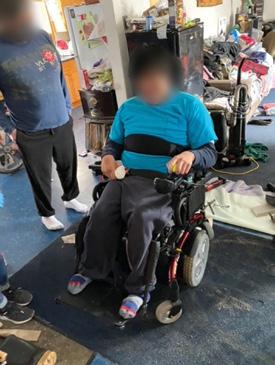
We traveled back to the community to continue training sessions with Tristan, utilizing the Dalhousie Wheelchair Skills Program to provide evidencebased practice. The extended trial period and skills-building work done with the client led to him being able to demonstrate the abilities required to be eligible for power mobility.
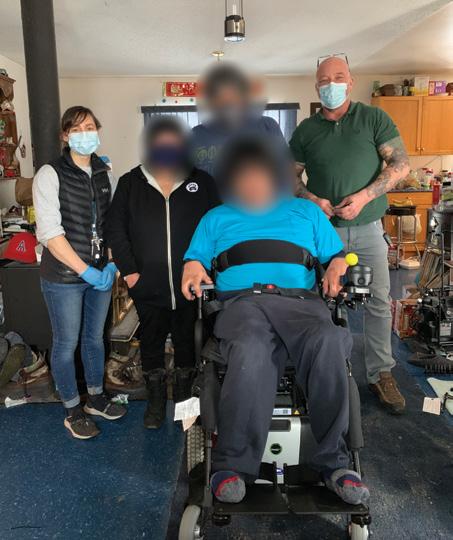
“ONE DAY IS NOT ENOUGH. THAT WAS THE MANTRA WE FOLLOWED TO ENABLE A YOUNG MAN’S GOAL OF POWER MOBILITY.”Tristan is all smiles showing off his continuous power chair training
Once the funding application was approved, a new power wheelchair was ordered specifically for Tristan and delivered to him. This success story highlights the incredible, positive client outcomes when families, clients, clinicians and suppliers work together using evidence-based training to enable a client’s goals to be met.

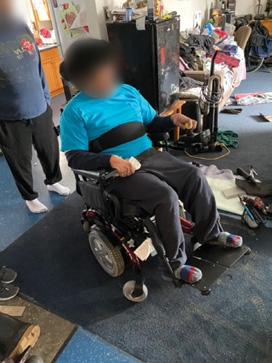


CONTACT THE AUTHOR
Rob may be reached at ROBERT.FUZESI@HMEBC.COM
CONTACT THE AUTHOR
Nicole may be reached at NICOLE.SAXVIK@HMEBC.COM


Rob Fuzesi, RRTS®, is a senior sales team member with HME Mobility & Accessibility in Richmond, British Columbia. With nearly 30 years of experience in the medical equipment field, he is skilled in providing clients with the correct long-term care and rehab equipment to meet their medical needs. Fuzesi has been a NRRTS Registrant since January 2021.

Nicole
is a senior
with HME Mobility &
in Richmond, British Columbia. Saxvik’s background includes kinesiology and more than three and a half years of experience in the medical field. Saxvik is qualified in all aspects of rehab medical equipment. She works with a diverse group of clients ranging from pediatric to geriatric.. Saxvik has been a NRRTS Registrant since January 2021.
Congratulations to the newest NRRTS Registrants. NAMES INCLUDED ARE FROM JULY 13 THROUGH SEPT. 18, 2021
Alexander De Groot, RRTS®
HomEquip
385-550 Century St
Winnipeg, Manitoba R3H0Y1
Telephone: 204-949-2300
Registration Date: 08/03/2021
Aundre Judge, RRTS®
AmeriMed Pharmacy & Equipment, LLC
3782 Old US Hwy 41 N
Valdosta, GA 31602
Telephone: 229-253-0067
Registration Date: 08/02/2021
Blake Faulk, RRTS®
National Seating & Mobility, Inc.
207 Roto Park Dr.
Broussard, LA 70518
Telephone: 337-352-0244
Registration Date: 07/15/2021
Brandon Matthews, RRTS®
Progressive Mobility & Medical
320 Cameron Rd
Washington, PA 15301
Telephone: 724-228-4568
Registration Date: 08/31/2021
Brian Caissie, RRTS®
Embracor Medical
467 Adelard-Savoid Blvd
Dieppe, New Brunswick E1A7E7
Telephone: 506-382-5780
Registration Date: 08/26/2021
David Witzman, RRTS®
Handi-House Limited
203 Colonnade Rd S, Units 13-14
Ottowa, Ontario K2E7K3
Telephone: 613-728-1115
Registration Date: 08/03/2021
Francesca Whitaker, RRTS®
Health Aid of Ohio
5230 Hauserman Rd
Parma, OH 44130
Telephone: 216-970-3410
Registration Date: 08/18/2021
Hillary Burch, RRTS®
Aabon Home Health Care Supply
136 E Reynolds St
Ozark, AL 36360-1530
Telephone: 334-774-7535
Registration Date: 07/15/2021
Jason Nye, RRTS®
Xperience Home Health Care
55 Eddinborough St Unit 130
Windsor, Ontario N8X3C3
Telephone: 519-800-0000
Registration Date: 09/10/2021
Jen Jakovcic, RRTS® Xperience Home Health Care
55 Eddinborough St Unit 130
Windsor, Ontario N8X3C3
Telephone: 519-800-0000
Registration Date: 09/02/2021
Jillian Petrillo, RRTS® Motion
3166 Portage Ave, Ste 6
Winnipeg, Manitoba R3K0Y5
Telephone: 204-832-9963
Registration Date: 08/03/2021
Joshua Bryant, ATP, CRTS® Patients Choice LLC
3519 Church St Unit D Clarkston, GA 30622
Telephone: 770-905-4456
Registration Date: 09/07/2021
Karly Davidson, RRTS® Xperience Home Health Care
55 Eddinborough St Unit 130
Windsor, Ontario N8X3C3
Telephone: 519-800-0000
Registration Date: 08/31/2021
Kristin Phillips, RRTS®
NSM-Canada
8620 Glenlyon Pkway #101
Burnaby, British Columbia V5J0B6
Telephone: 778-227-4099
Registration Date: 09/07/2021
Latoria Cooke, RRTS® Numotion
6350 Regency Pkwy Ste 540
Norcross, GA 30071
Telephone: 470-568-1581
Registration Date: 07/13/2021
Michael Sorokowsky, RRTS®
Handi-House Limited
203 Colonnade Rd S Units 13-14
Ottawa, Ontario K2E7K3
Telephone: 613-728-1115
Registration Date: 07/23/2021
Michael Rondeau, RRTS®
Trustcare Home Medical Equipment
8677 Telegraph Rd
Glen Allen, VA 23060
Telephone: 804-262-9001
Registration Date: 08/12/2021
Raymond Johnstone, RRTS®
Canada Care Medical Inc.
101-1865 Leslie Stx
North York, Ontario M3B2M3
Telephone: 416-241-1133
Registration Date: 08/16/2021
Renee Balash, RRTS® Motion
4720-50th Ave
Red Deer, Alberta T4N4A1
Telephone: 403-358-3825
Registration Date: 09/03/2021
Sally Buxton, RRTS®
Boggio Family of Pharmacies
200 Catharine St
Port Colborne, Ontario L3K4K8
Telephone: 905-834-3514
Registration Date: 08/18/2021
Sean P. Reed, ATP, CRTS®
National Seating & Mobility, Inc.
37326 Commerce Ln
Prairieville, LA 70769-3349
Telephone: 225-673-2001
Registration Date: 08/01/2021
Stephen Whitman, RRTS®
Lawtons Home Healthcare
90 Main St
Dartmouth, Nova Scotia B2X1R5
Telephone: 902-401-8405
Registration Date: 08/17/2021
Tammy McDowell, RRTS®
Boggio Family of Pharmacies
200 Catharine St
Port Colborne, Ontario L3K4K8
Telephone: 905-834-3514
Registration Date: 08/09/2021
Trisha Swan, RRTS®
Embracor Medical
121 Ilsley Ave, Unit 101-102
Dartmouth, Nova Scotia B3B1S4
Telephone: 902-482-2300
Registration Date: 07/14/2021
Warren Stuart, RRTS®
Embracor Medical
121 Ilsley Ave, Unit 101-102
Dartmouth, Nova Scotia B3B1S4
Telephone: 902-482-2300
Registration Date: 08/09/2021
Xavier Garza, ATP, RRTS® Medical Plus Supplies
4025 W Fuqua St Houston, TX 77045
Telephone: 713-440-6700
Registration Date: 08/02/2021
Congratulations to NRRTS Registrants recently awarded the CRTS® credential. A CRTS® receives a lapel pin signifying CRTS® or Certified Rehabilitation Technology Supplier® status and guidelines about the correct use of the credential. NAMES LISTED ARE FROM JULY 13 THROUGH SEPT. 18, 2021
Joshua Bryant, ATP, CRTS® Patients Choice LLC Clarkston, GA
Walter Tejada, ATP, CRTS® Browning’s Pharmacy & Health Care Winter Garden, FL
The NRRTS Board determined RRTS® and CRTS® should know who has maintained his/her registration in NRRTS, and who has not. NAMES INCLUDED ARE FROM JULY 13 THROUGH SEPT. 18, 2021, 2021 FOR AN UP-TO-DATE VERIFICATION ON REGISTRANTS, VISIT WWW.NRRTS.ORG, UPDATED DAILY.
Perry Kohorn, ATP Oak Creek, WI
Mark Partridge Norcross, GA
David Wix, ATP Jacksonville, FL
William Cavender, ATP/SMS Midland, TX
Jodi Baumgard, ATP Brooklyn Park, MN
Shannon Lee Cook, ATP Huntsville, AL
Sam Agner, ATP Longwood, FL
Chuck Harris, ATP Eatonton, GA
Morgan Bray Henrico, VA
Cassi Jo Richardson, ATP Redding, CA
Timothy O’Connor, ATP Toms River, NJ
Kimberly Vaughn, ATP Sprinfield, MO
David Morasso, ATP Lansing, MI
Carlos Rosas Reno, NV
Neal Webb Reno, NV
Alvin Parrish Chattanooga, TN
Neal Clay Hall, ATP Tavares, FL
Marcy is an anterior rollator/gait trainer sized for the youngest walker. Whether for therapy or every day activities, Marcy is a child’s best friend for walking and play. Adjustability and adaptability allows Marcy to change and grow as needs change. Accessories offer maximum variability.
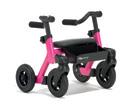

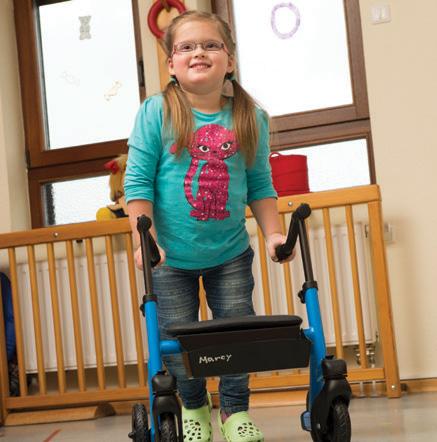
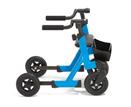
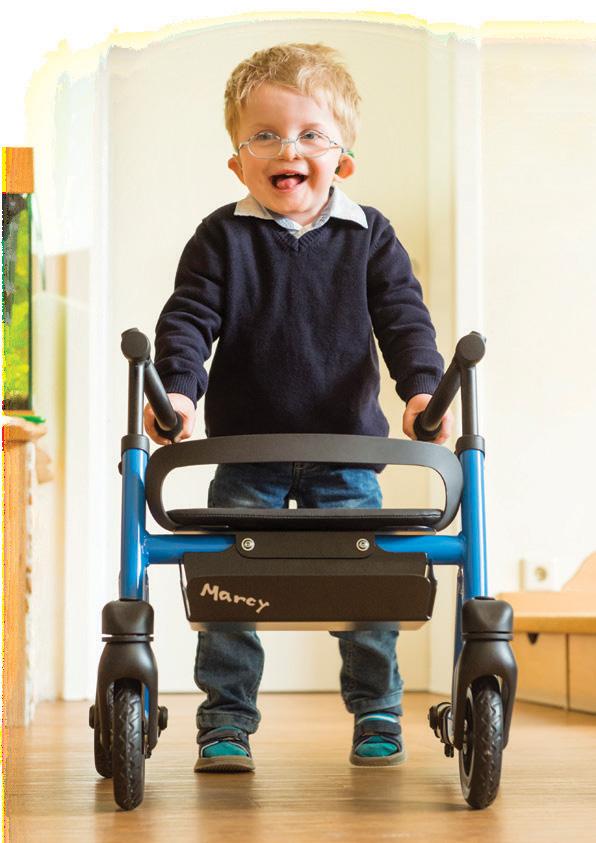
Fun colors to encourage use
4 sizes, 8 models let you choose best size
Hand grips and support pad choices
Options for braking and motion controls
The following individuals renewed their registry with NRRTS between July 13 through Sept. 18, 2021.
PLEASE NOTE IF YOU RENEWED SEPT. 19, 2021, OR AFTER, YOUR NAME WILL APPEAR IN A FUTURE ISSUE OF DIRECTIONS. IF YOU RENEWED PRIOR TO JULY 13, YOUR NAME IS IN A PREVIOUS ISSUE OF DIRECTIONS.
FOR AN UP-TO-DATE VERIFICATION ON REGISTRANTS, PLEASE VISIT WWW.NRRTS.ORG, WHICH IS UPDATED DAILY.
Alan Derr, ATP, CRTS®
Albert Alvarado, ATP, CRTS®
Albert Baxter, ATP, CRTS®
Alex Biello, ATP, CRTS®
Amanda Bult, RRTS®
Andrew Cantrell, ATP, CRTS®
Benjamin Jones, RRTS®
Bob G. Poole, ATP, CRTS®
Bradley R. Gooch, MBA, ATP, CRTS®
Brian Coltman, ATP/SMS, CRTS®
Britt Sitzes, ATP/SMS, CRTS®
Bryan Benton, ATP, CRTS®
Charles E. Pfeifer, ATP, CRTS®
Christian Stephens, ATP, CRTS®
Clayton D. Cole, ATP, CRTS®
Coleman R Mansfield, ATP/SMS, CRTS®
Dan Thole, ATP, CRTS®
Darrell Aubrey, RRTS®
David Bachelder, ATP, CRTS®
Derek W.M. Ng, ATP, CRTS®
Donald W Callaway, ATP, CRTS®
Eric T. Smith, ATP, CRTS®
Frank A. Lane, ATP, CRTS®
Gerald Erkhart, ATP, CRTS®
Gregg M. Platis, ATP, CRTS®
James Blair, ATP, CRTS®
James C. Bond, ATP, CRTS®
Jarrod Rowles, ATP/SMS, CRTS®
Jason Kelln, ATP, CRTS®
Jason Cook, ATP, CRTS®
Jason S. Lovato, ATP, CRTS®
Jay Krusemark, ATP, CRTS®
Jeff Cysewski, ATP, CRTS®
Jeff Lane, ATP, CRTS®
Jeffrey C. Ray, ATP, CRTS®
Joe Wood, RRTS®
John Small, ATP, CRTS®
Jonathan C Adams, ATP, CRTS®
Jordan Joslin, ATP/SMS, CRTS®
Jose Escobedo, ATP, CRTS®
Joseph Vance Bryant, ATP, CRTS®
Julian C. Fiske, ATP, CRTS®
Julie McCallum, ATP, CRTS®
Justin Whittington, ATP, CRTS®
K. Brandon Cowart, ATP, CRTS®
Karen Bussey, ATP, CRTS®
Kathy Fowler, ATP, CRTS®
Kenneth White, ATP, CRTS®
Kenneth Gibbons, ATP, CRTS®
Kevin Wallace, ATP, CRTS®
Kevin J. Mooney, ATP, CRTS®
Kristen Maak, OTR/L, ATP, CRTS®
Lisa Hammock, ATP, CRTS®
Lyle Haynes, ATP, CRTS®
Lynn Ferguson, ATP, CRTS®
Matthew Lippy, ATP, CRTS®
Michael Thayer, ATP, CRTS®
Michael P. Seidel, ATP, CRTS®
Michael T. Crown, ATP, CRTS®
N. Jose Salazar, ATP, CRTS®
Phillip Belcher, ATP, CRTS®
Phillip D. Swanson, ATP, CRTS®
Robert Garwood, ATP, CRTS®
Robert Brent Hudson, ATP, CRTS®
Robert E. White, ATP, CRTS®
Robin Grider, ATP, CRTS®
Rose Ebner, ATP/SMS, CRTS®
Ryan J. Romero, ATP, CRTS®
Shadrach Lee, RRTS®
Sharon Frant Brooks, MA, OTR/L, ATP/SMS, CRTS®
Shean Wages, ATP, CRTS®
Stacy Lewis-Denmark, ATP, CRTS®
Stephen Clark, ATP, CRTS®
Ted L. Hyde, BFA, CO, FAAOP, ATP, CRTS®
Teresa “Gaye” Barger, ATP, RRTS®
Thomas C. Powell, IV, ATP, CRTS®
Tristan Yapuncich, ATP, CRTS®
Zeb Dugan, ATP/SMS, CRTS®
Nancy Greco, ATP, CRTS®
Nicholas Dodson, ATP, CRTS®
Jason P. Steiner, ATP, CRTS® BE SURE TO FOLLOW NRRTS ON SOCIAL MEDIA!
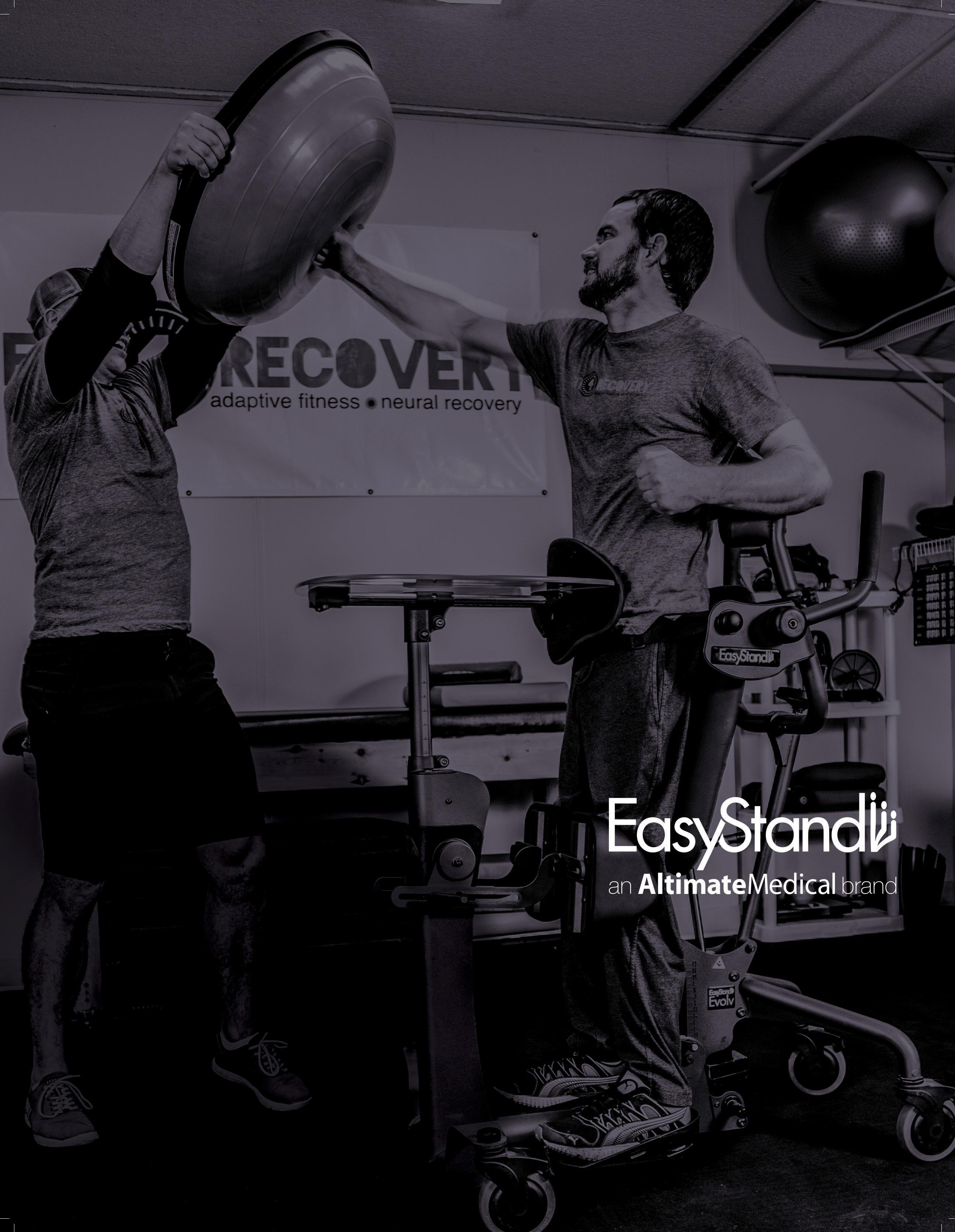





5815 82nd Street, Suite 145, Box 317













Lubbock, TX 79424
P > 800.976.7787
As Corporate Friends of NRRTS, these companies recognize the value of working with NRRTS Registrants and support NRRTS’ Mission Statement, Code of Ethics and Standards of Practice.





